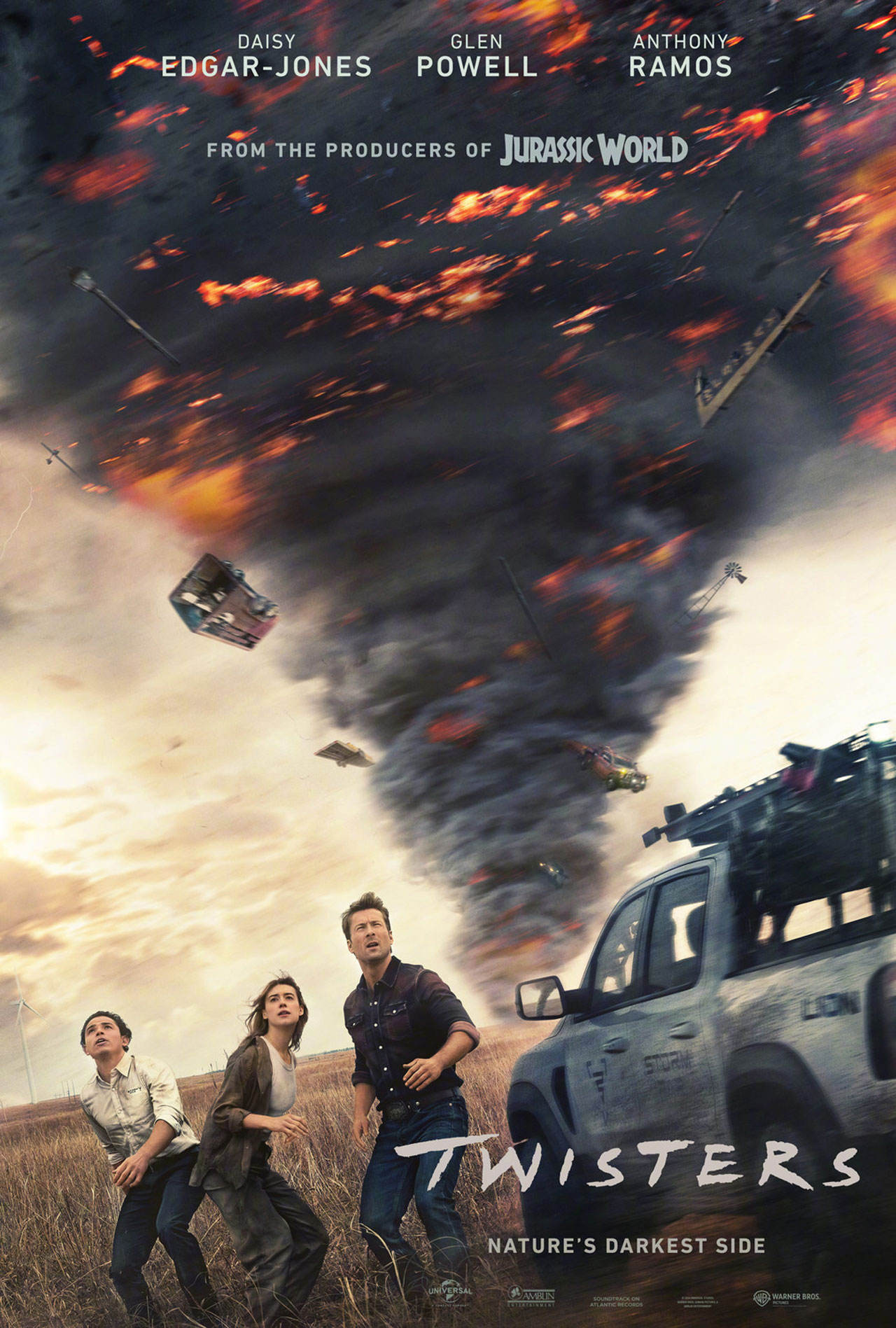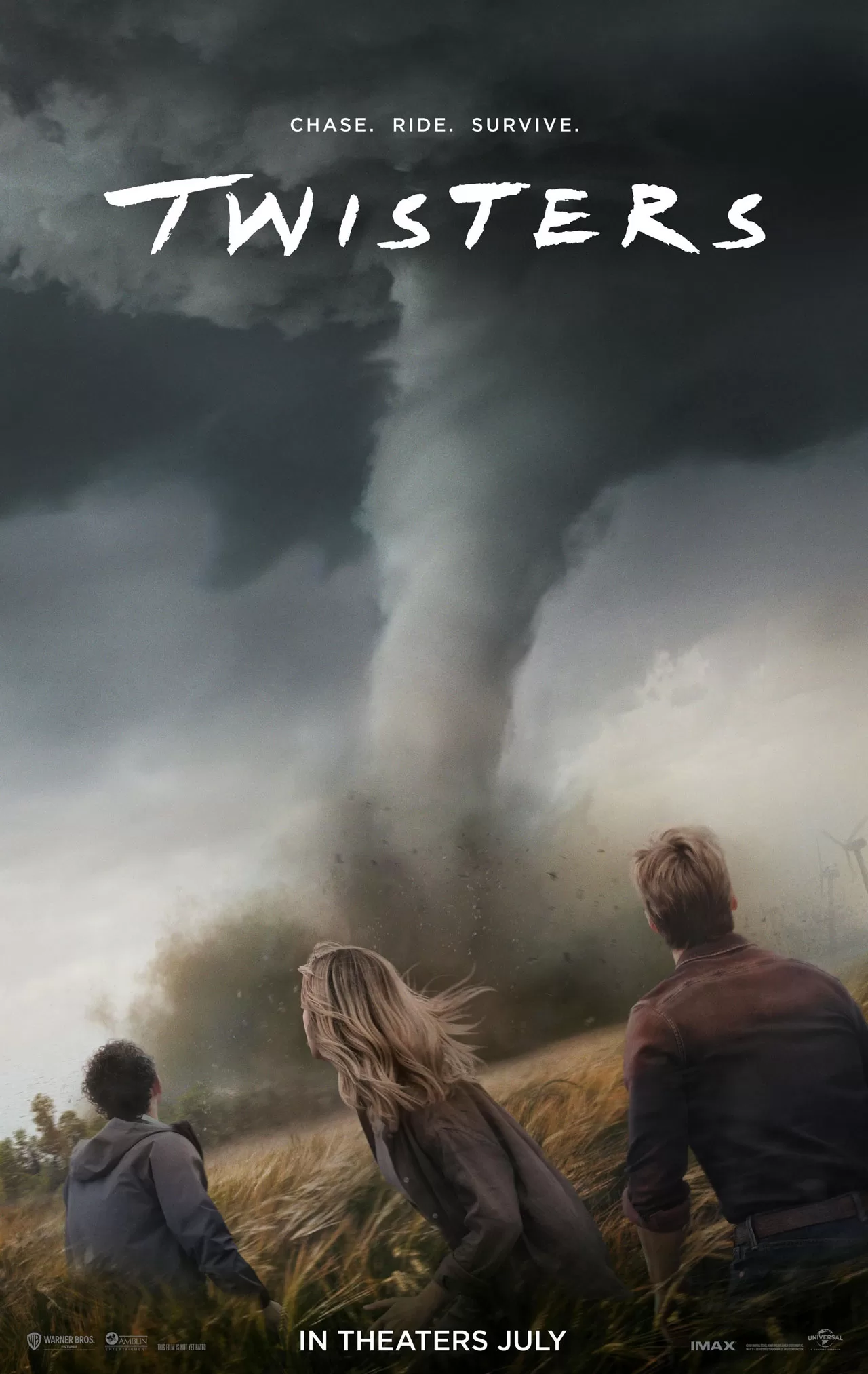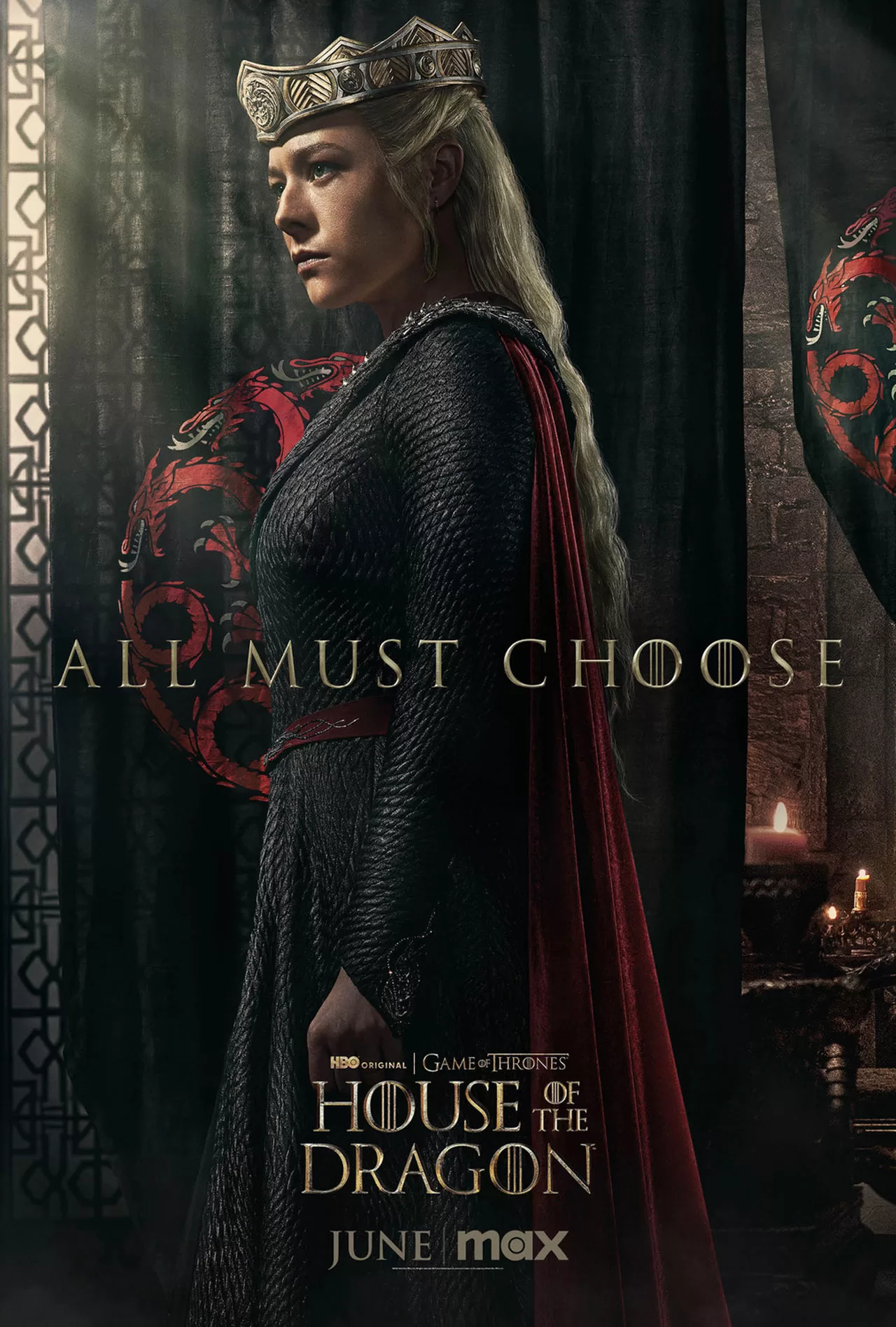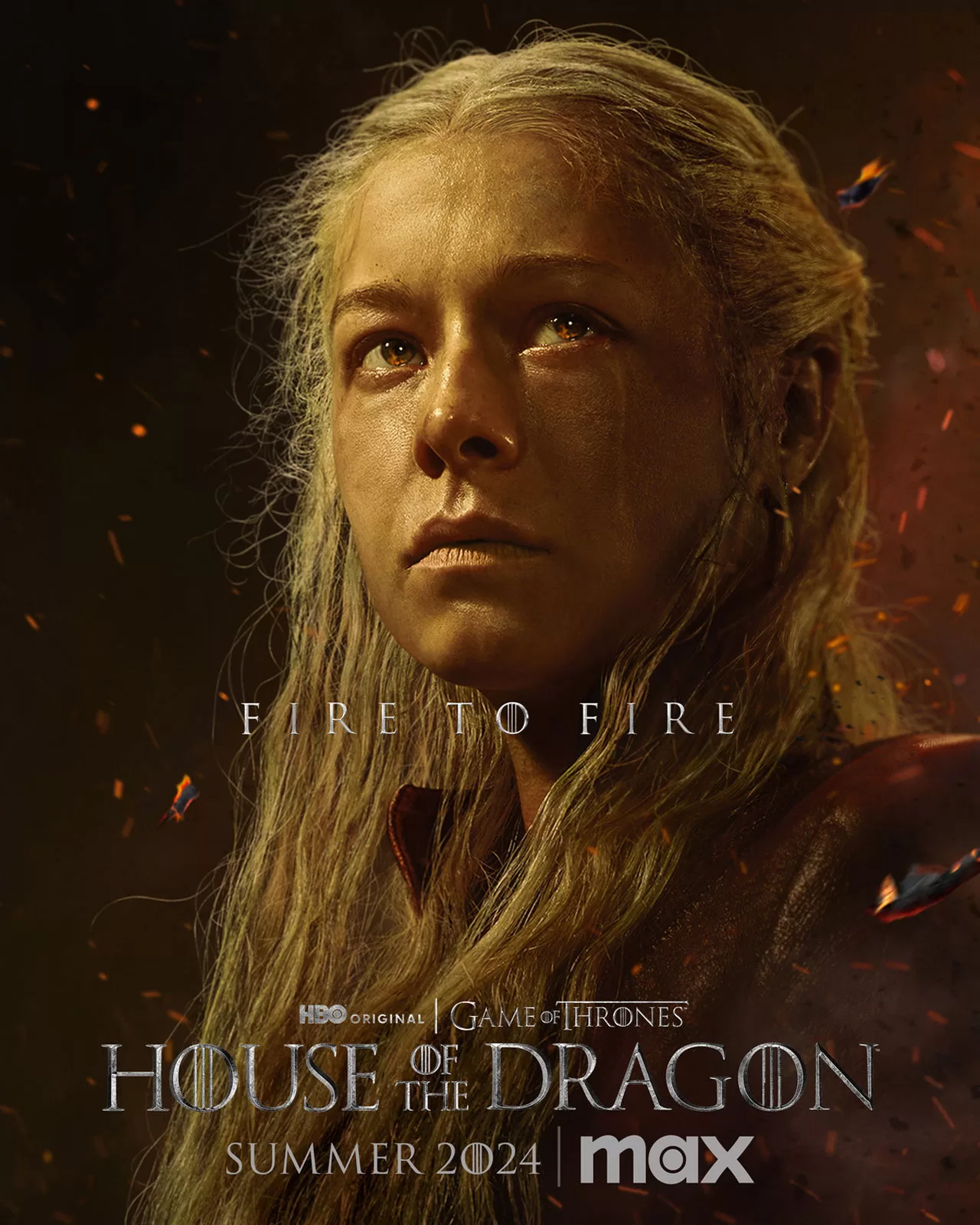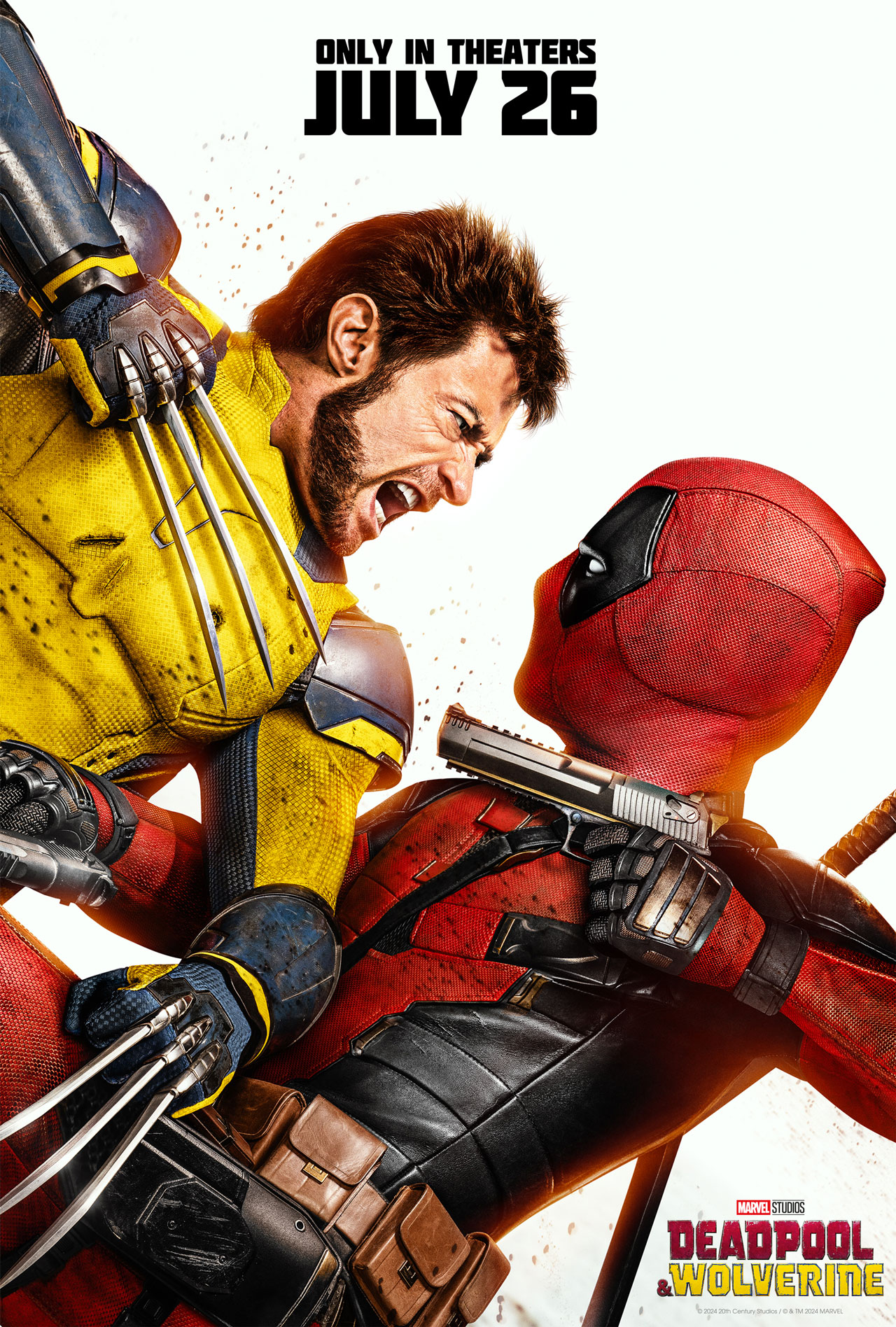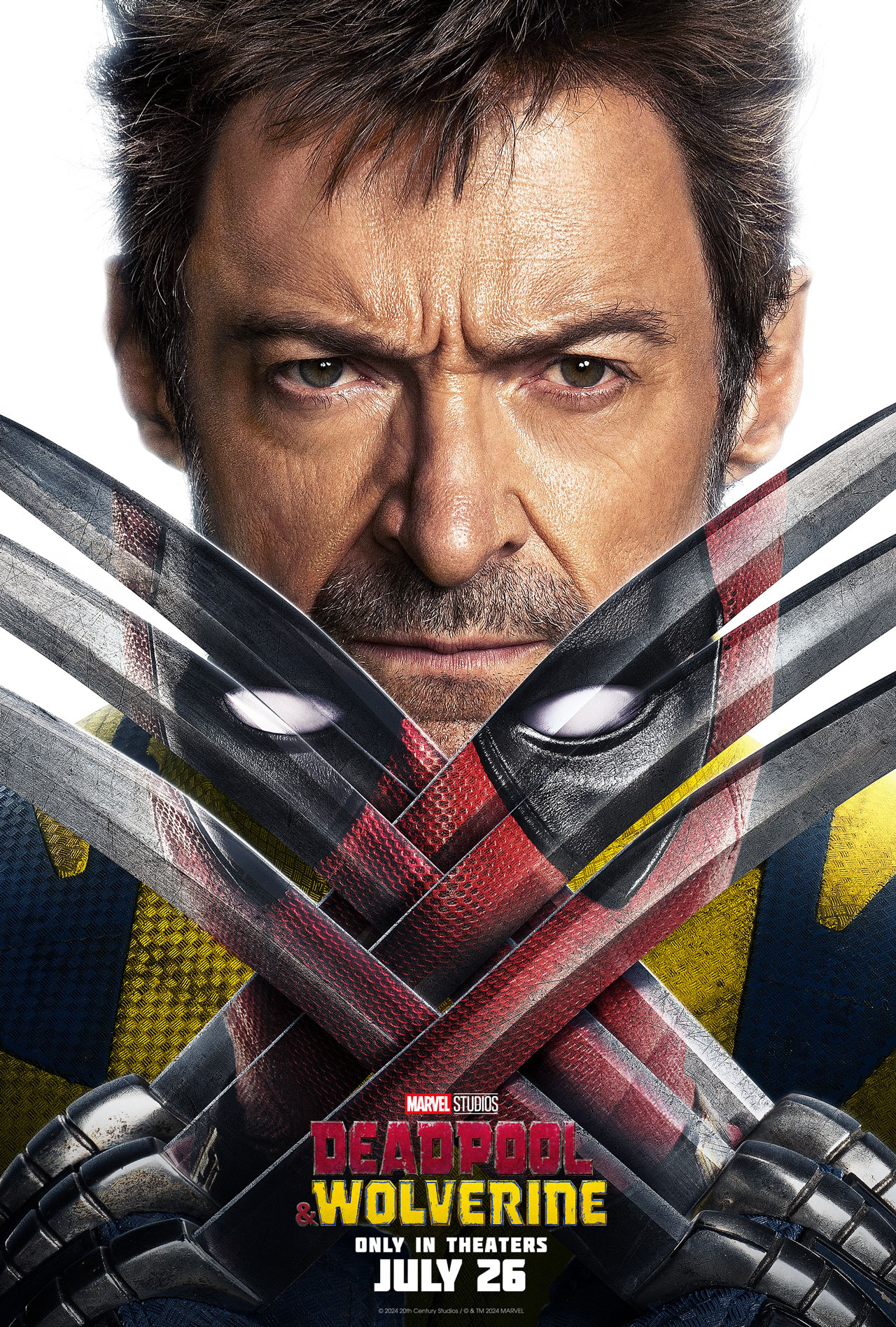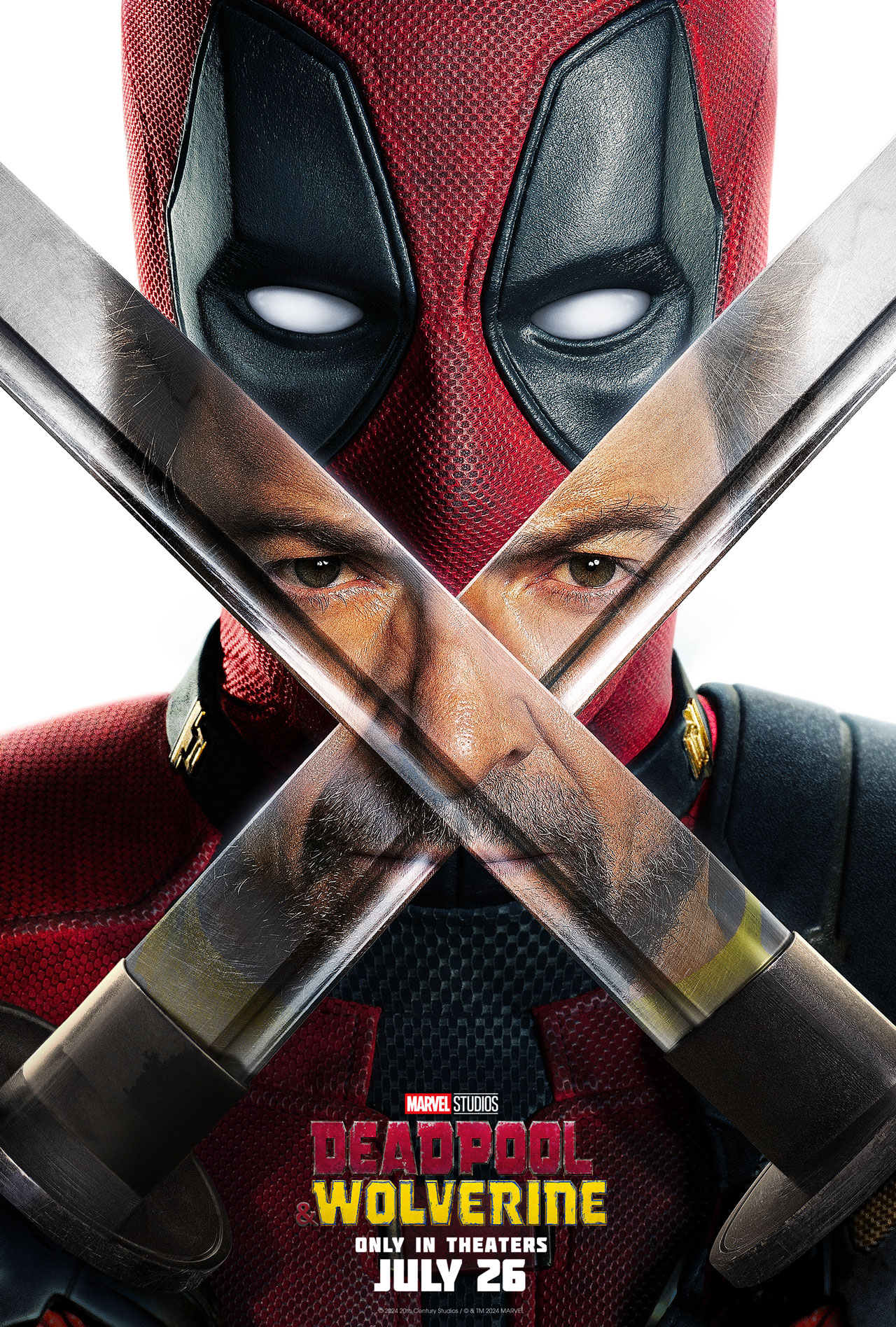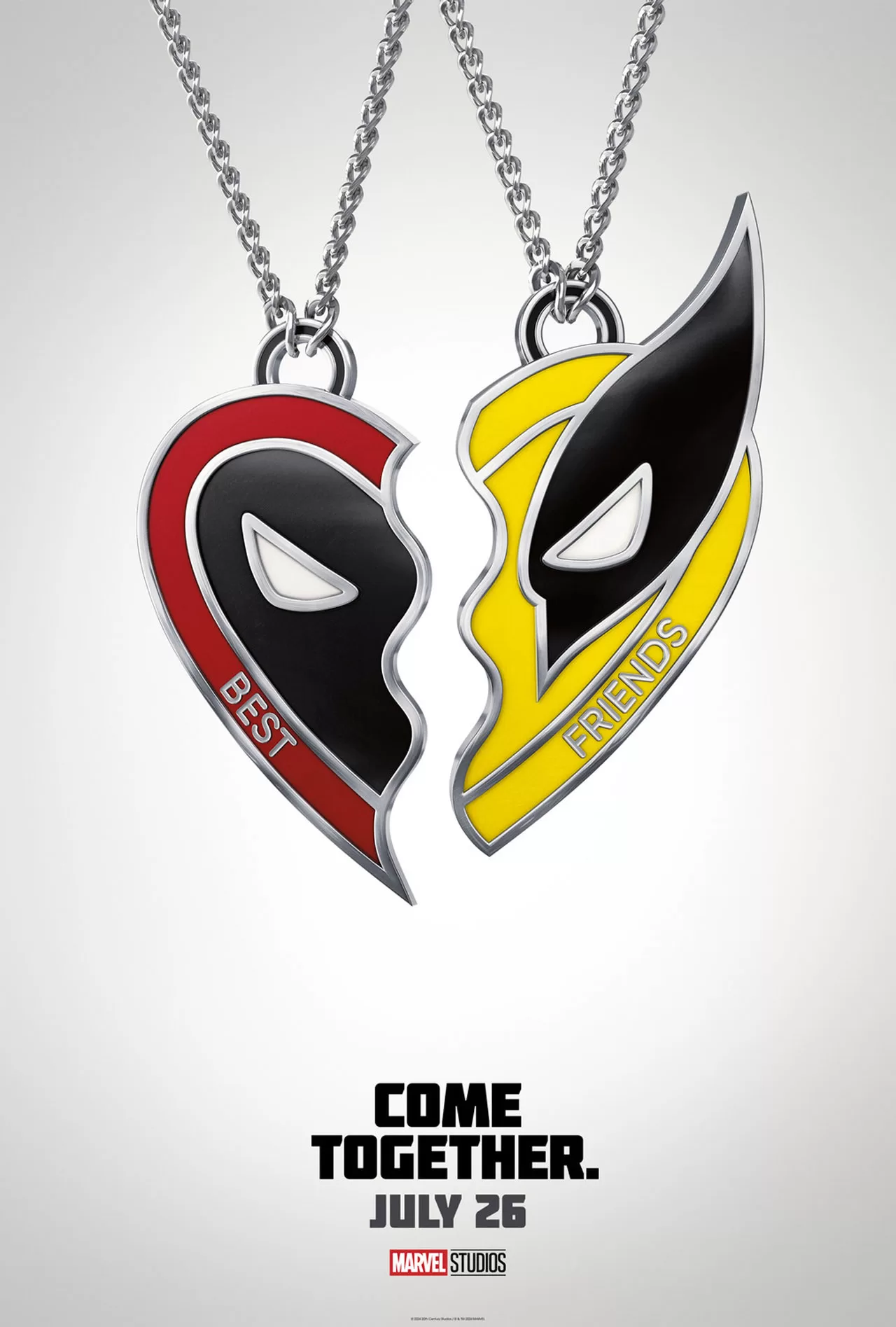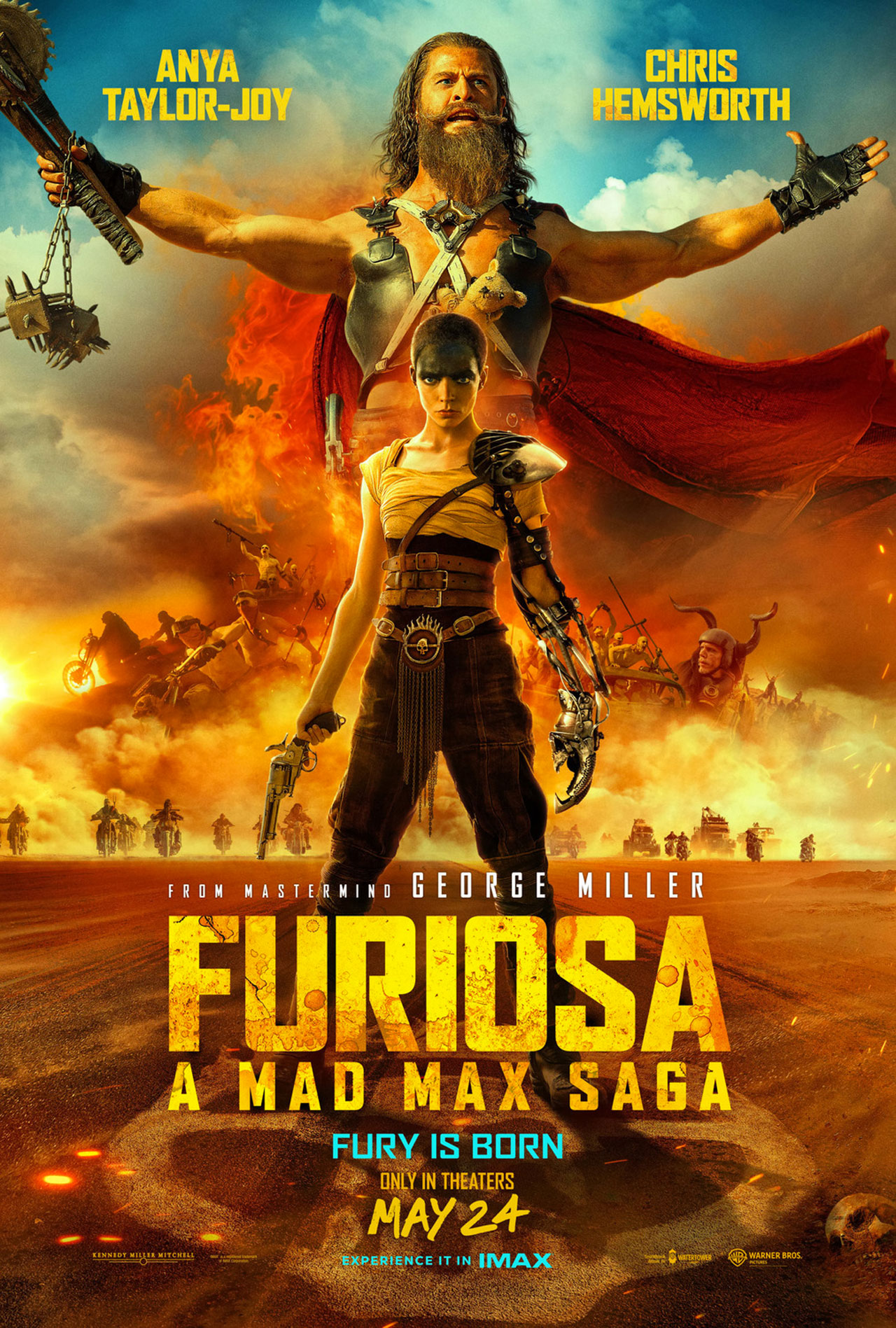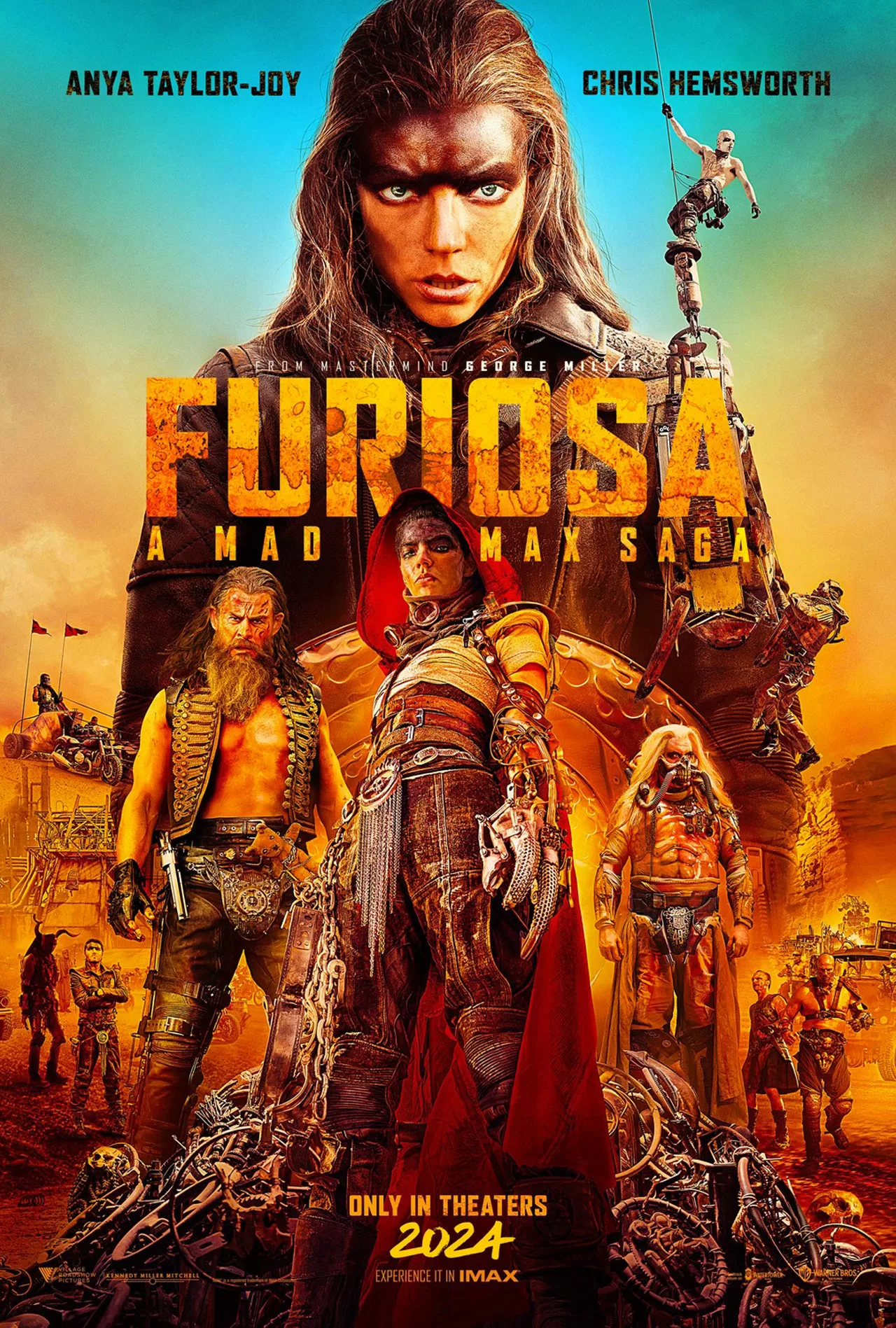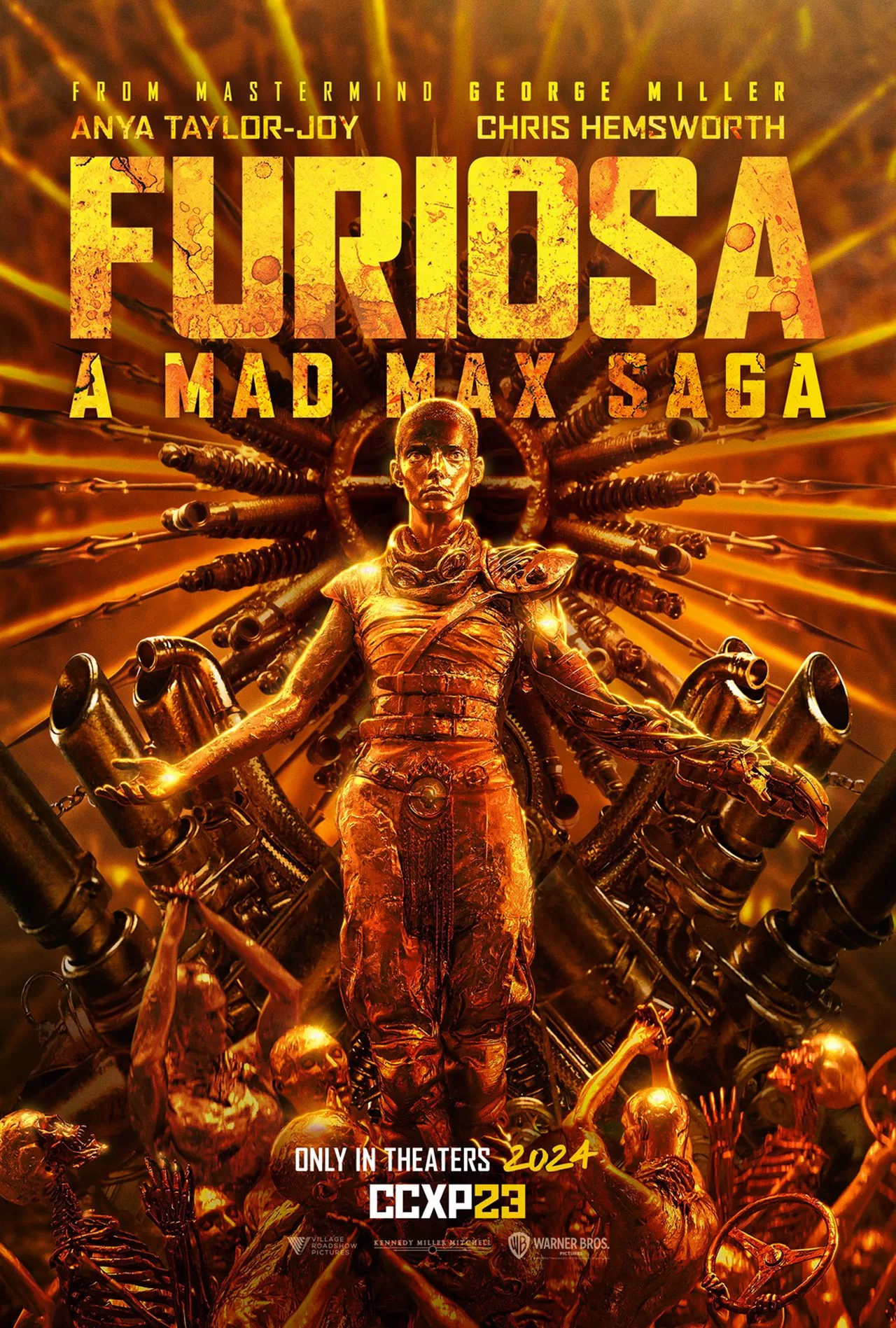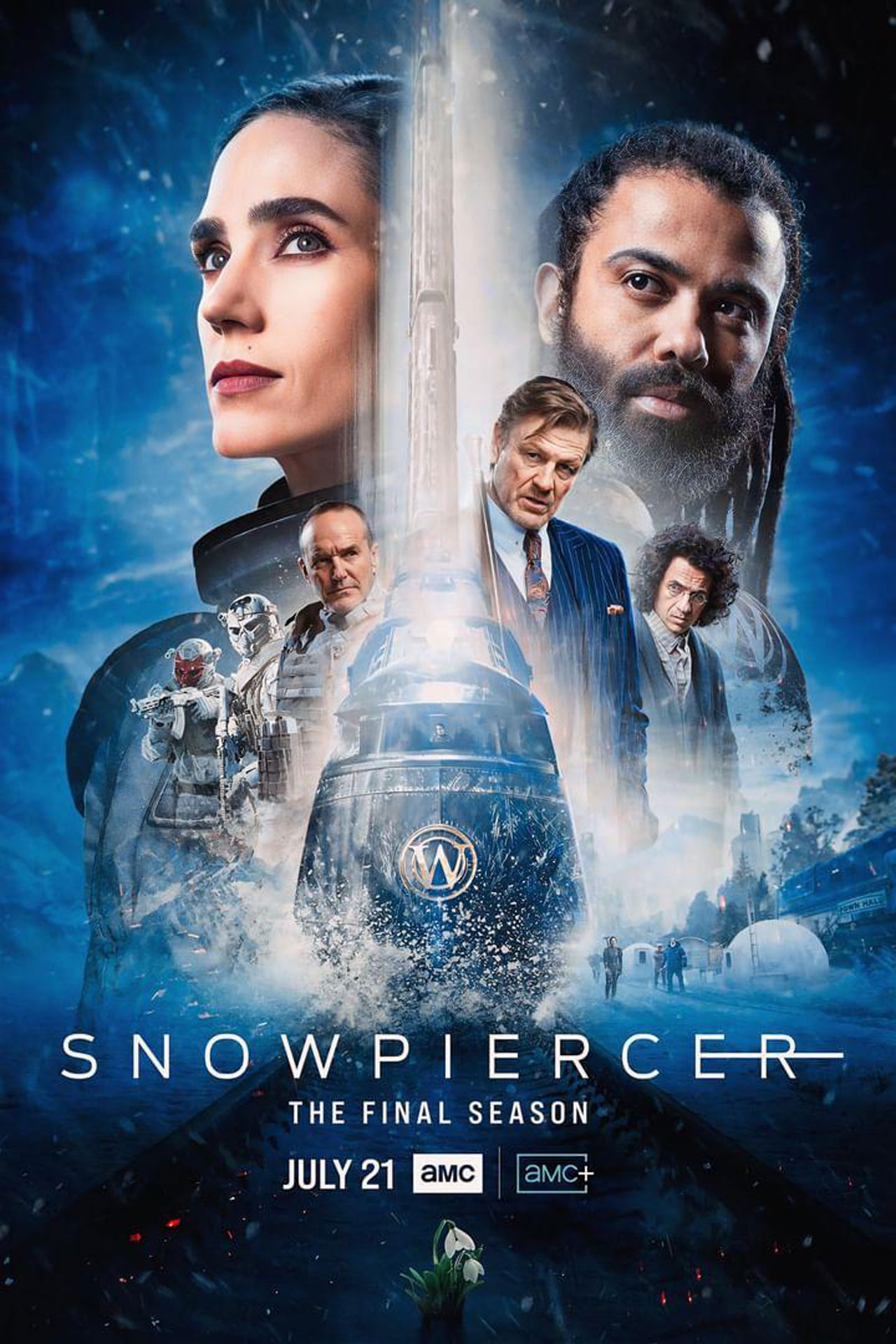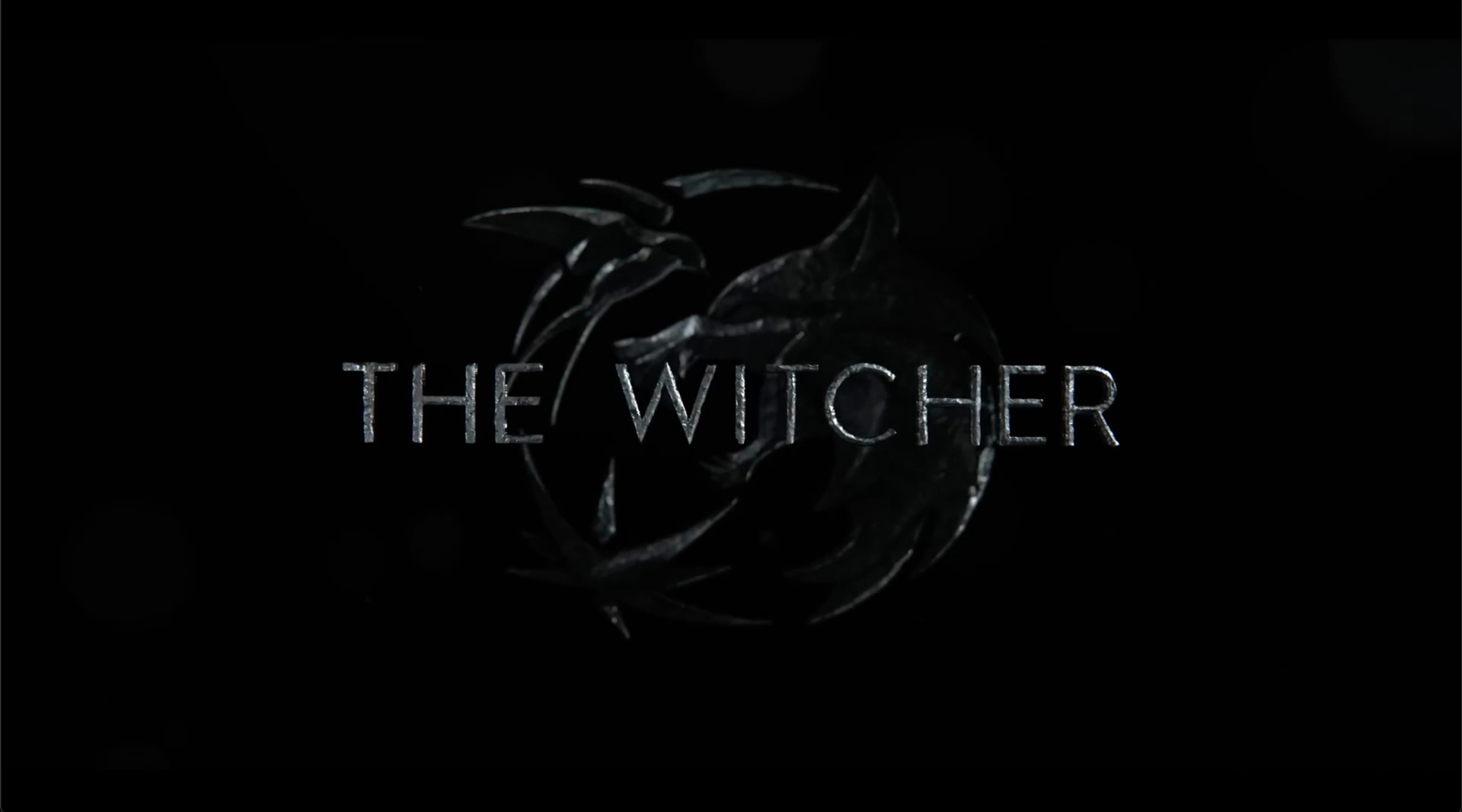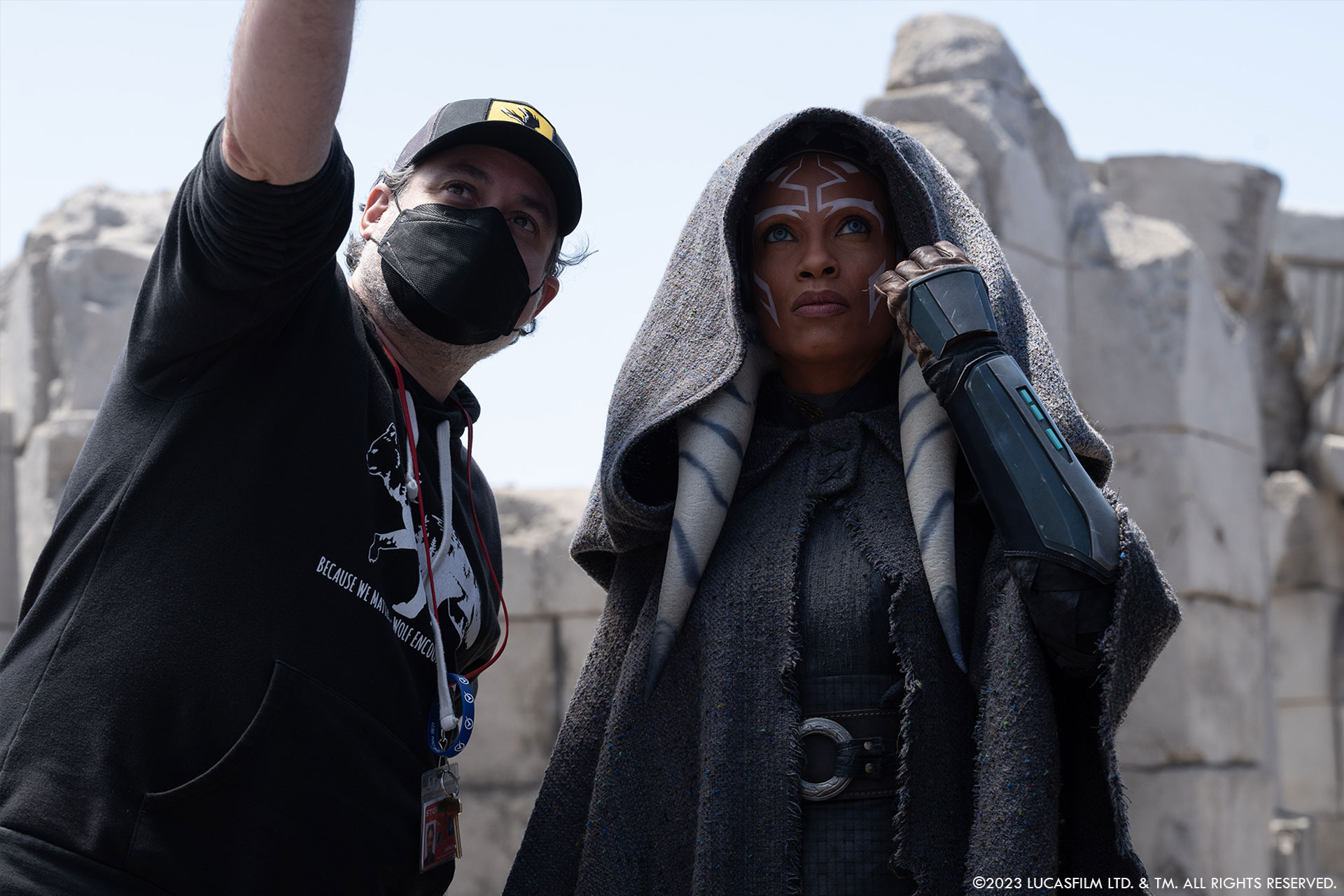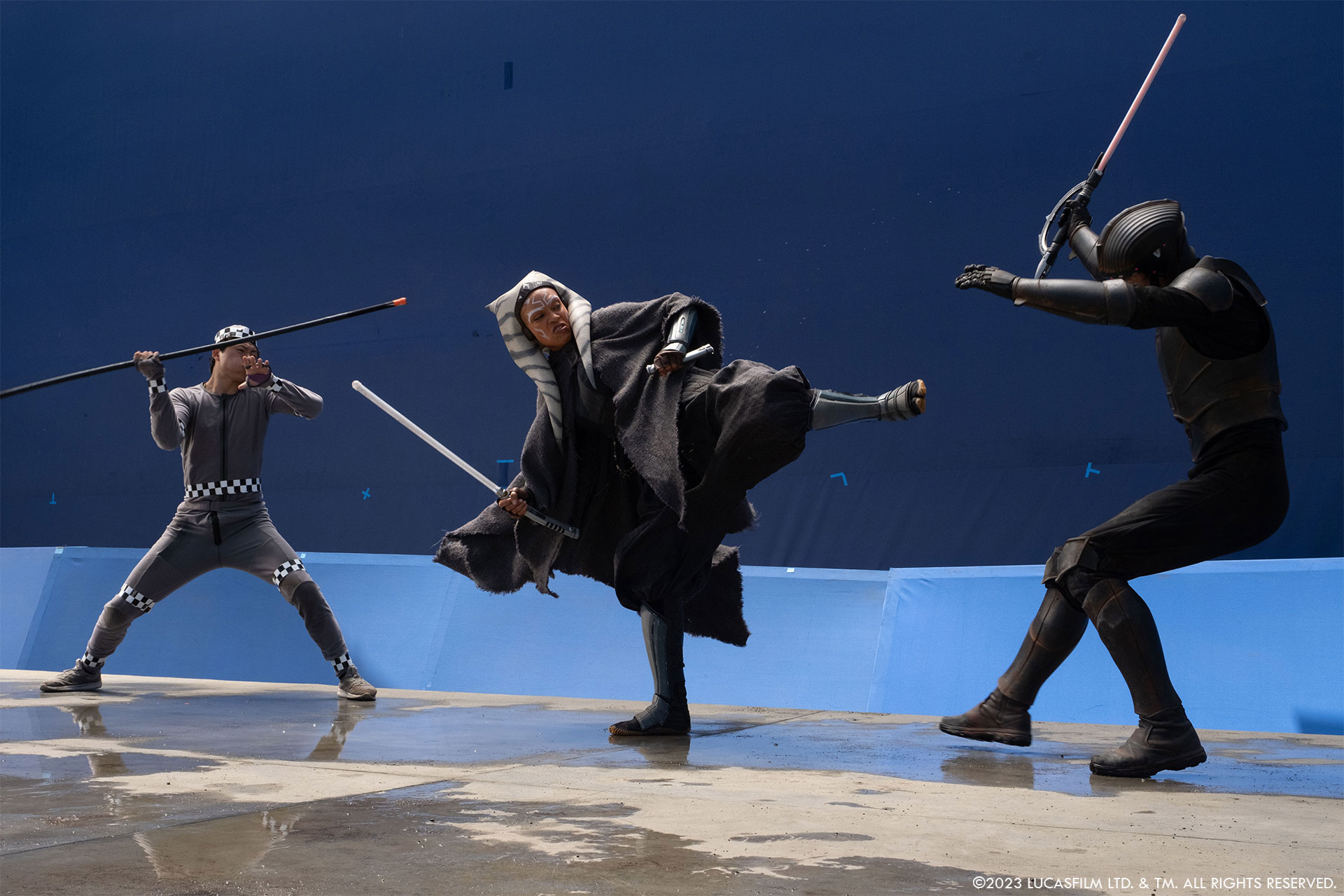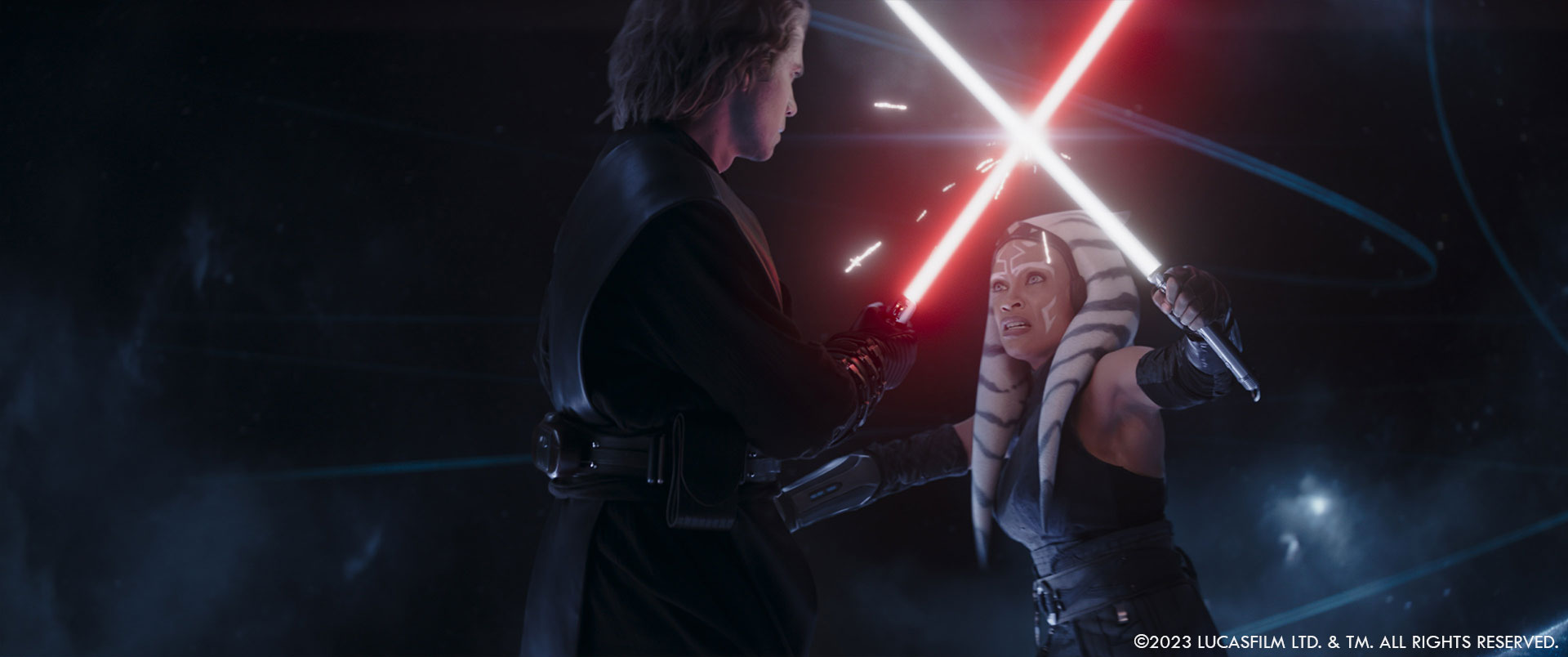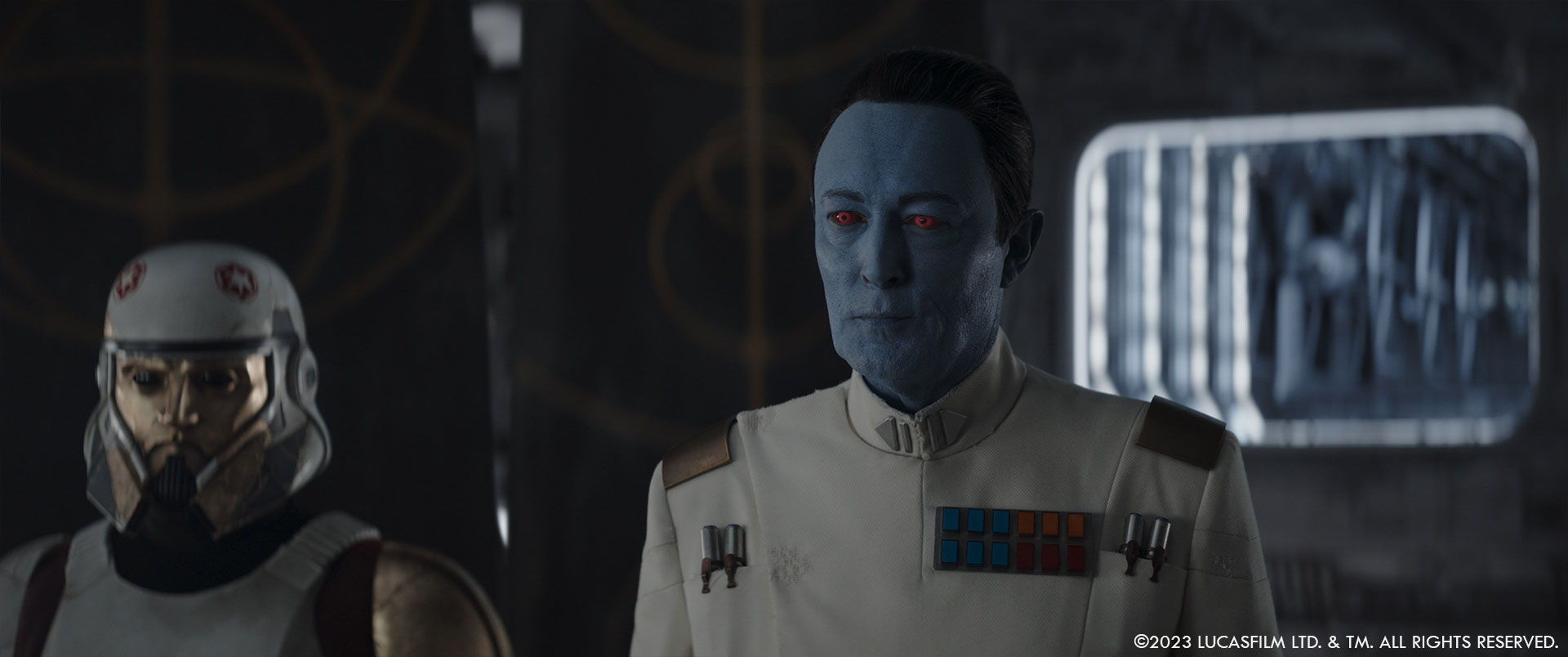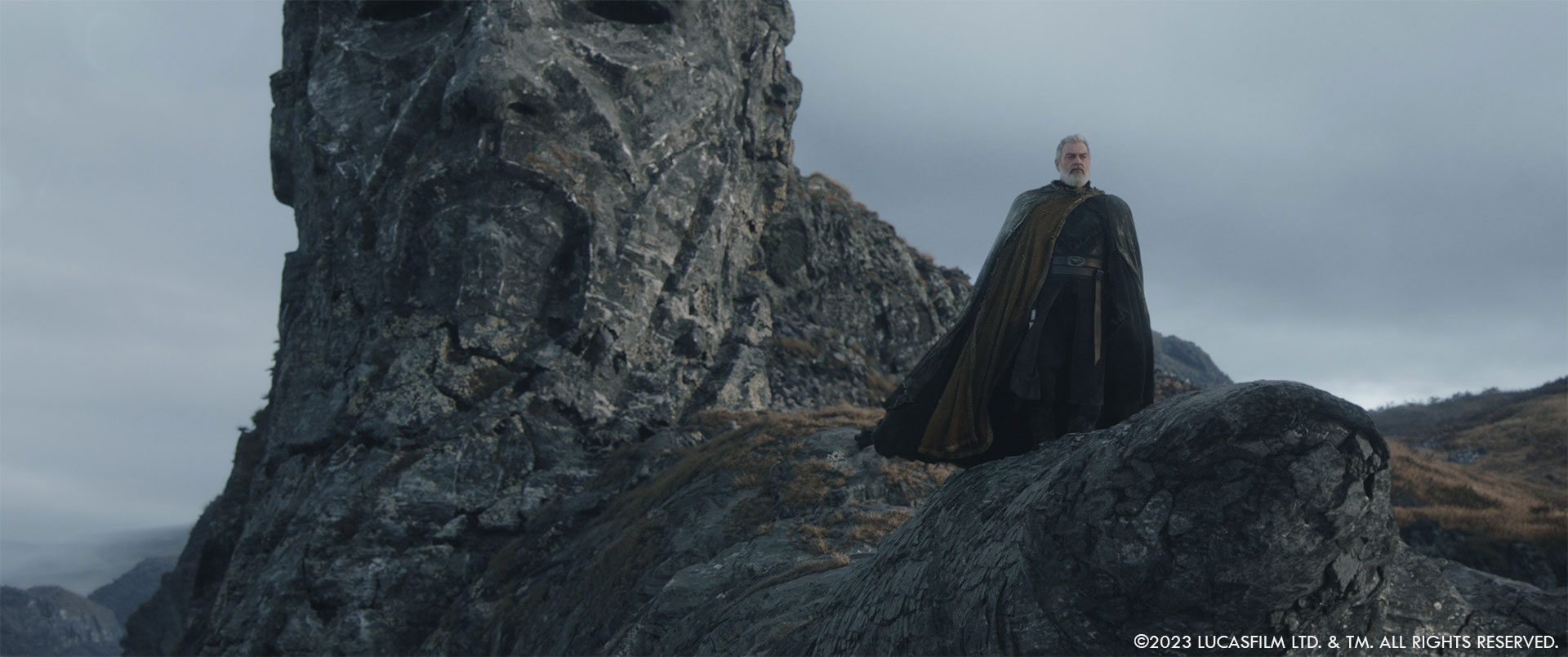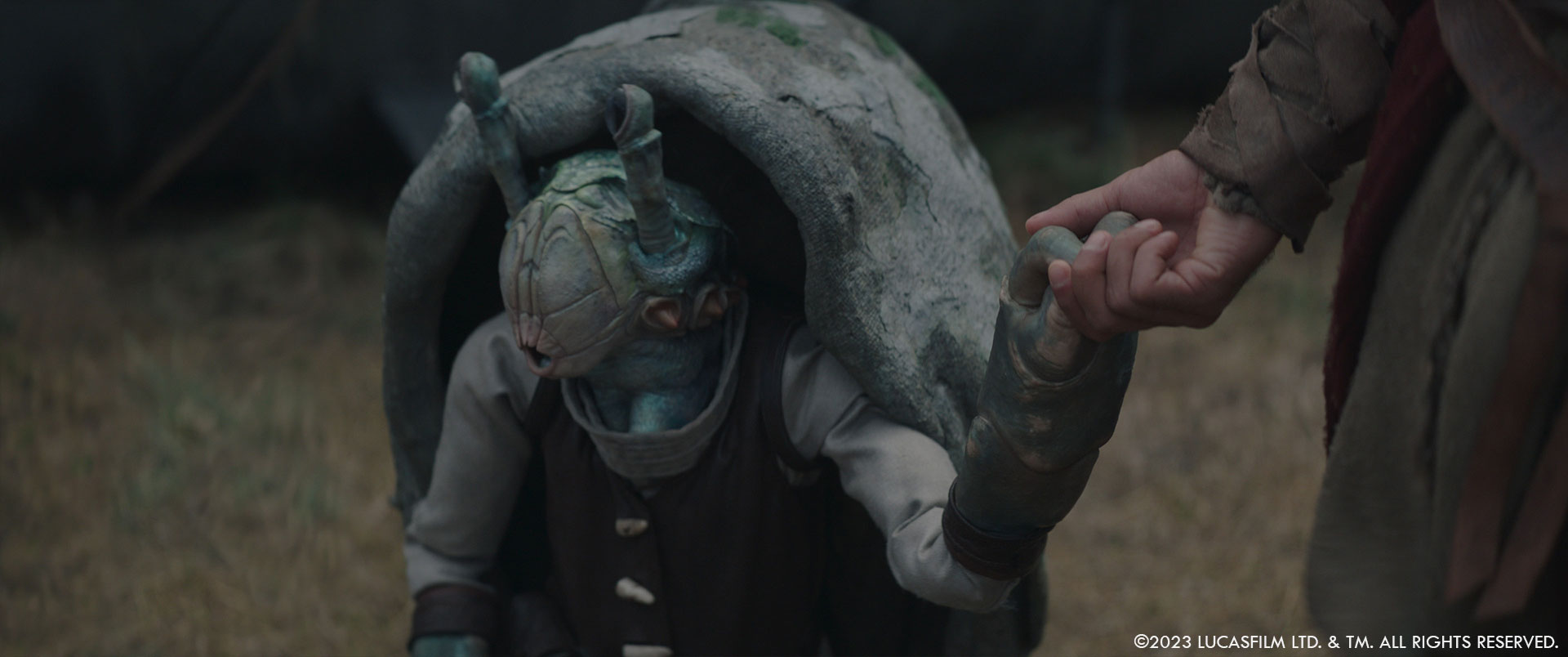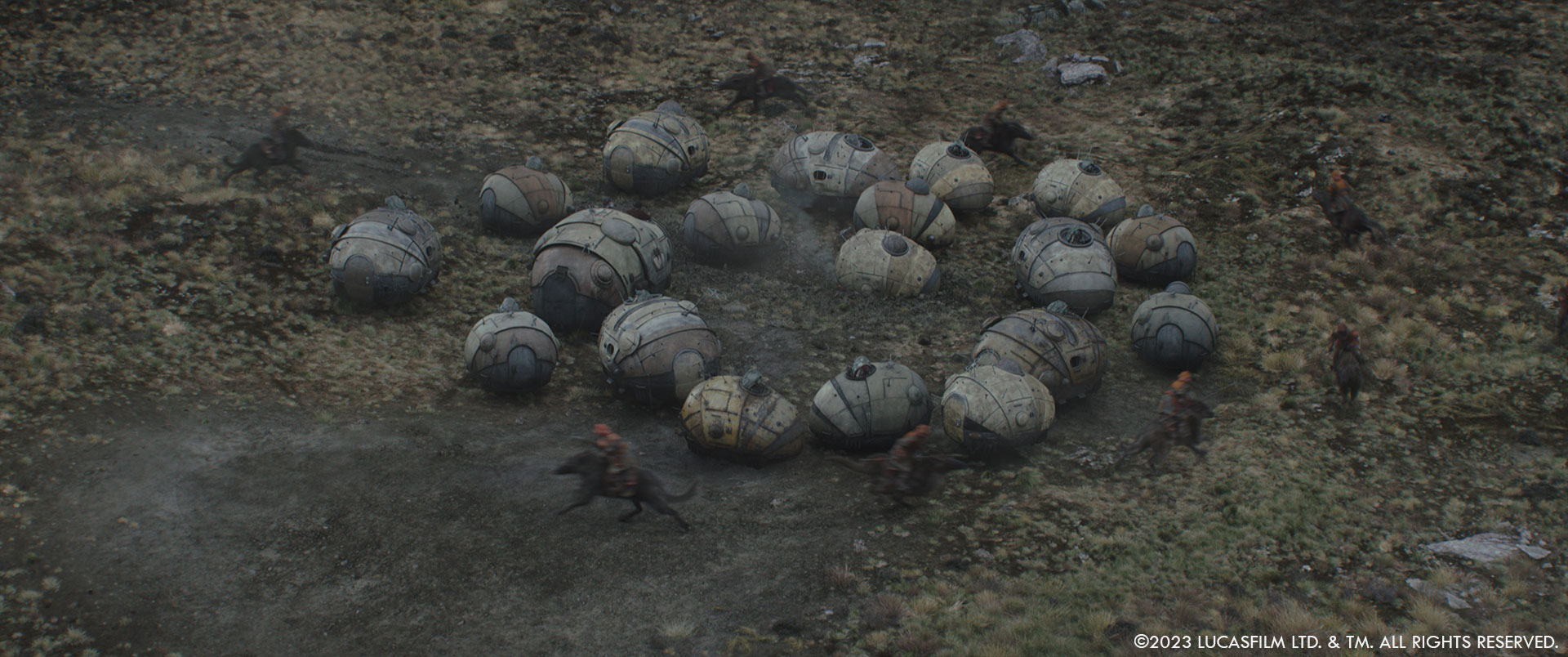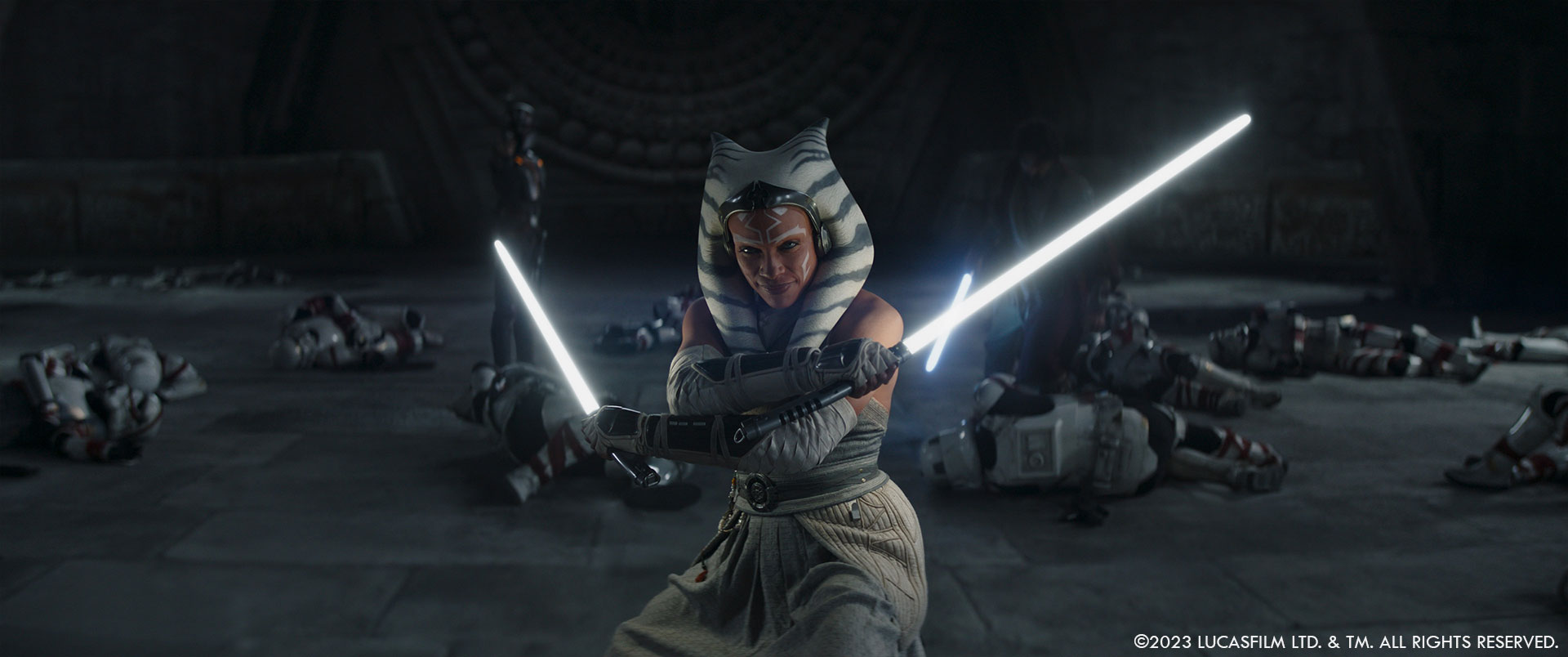Coming from Brazil, Roni Rodrigues launched his visual effects career in 2011 at BlueBolt, where he quickly made his mark on shows such as Spectre, Fast & Furious Presents: Hobbs & Shaw, News of the World, and The Wheel of Time.
What is your background?
I’m from Brazil and my background is in video editing. I’ve had quite an interesting journey into the visual effects world. I started in the industry back in 1999 as a Line Producer, then in 2001 I became a Video Editor and I was lucky enough to work on films like City of God, Elite Squad and City of Men, which were Brazilian projects.
In 2007 I moved to the UK, mainly to learn English, and I basically started again from zero. My first job in the UK was as a toilet cleaner, and then I became a bartender and a waiter. In 2010 I was accepted for a place at the National Film and Television School to do a Master’s in visual effects.
My first VFX project was The Iron Lady with Meryl Streep, and then I worked on Snow White and the Huntsman, and The Monuments Men, I was lucky enough to be part of the team that did The Imitation Game. My career kind of took off from there.
For the past four years I’ve been working mainly as a client-side VFX Supervisor, starting with the Paul Greengrass and Tom Hanks movie News of the World. I’ve been client side since then.
How did you get involved on this movie?
I am part of the Outpost VFX team and they were in touch with Paramount, who were looking for a suitable person to take on the role of Production VFX Supervisor. The Director, Reinaldo Marcus Green, wanted to get someone that wasn’t just able to achieve his vision but also someone with the sort of life experience that could really understand the background of the story. Someone who would have a better connection with the narrative. We all knew it would be a delicate project, not just for the Director but for the studio and for the Marley family – they wanted to make sure that everyone involved had an emotional connection to Bob Marley’s story.
I had talks with the Producers and they both really liked my story, particularly my connection with City of God, and then I had a nice conversation with Reinaldo the Director and we talked about films and my background, but most importantly what I thought I could bring to the project. After all those meetings I was delighted to be invited to be part of the team. I was part of the project from the pre-production phase, so I started back in October 2022 and we went for some scouting in Jamaica.
How was the collaboration with director Reinaldo Marcus Green?
Reinaldo and I had a lot of conversations at the beginning of the project during pre-production. He wanted to make this film feel as real as possible and really wanted to make sure we achieved historical accuracy, not just for the crowd work and the concerts but also the city environments like London and Kingston.
The collaboration was very important because it gave VFX a seat at the table early on, not just with the Director but also with the DOP and Production Designer, which gave us the best chance to replicate history and be super accurate. We did several tests and agreed to shoot as much practically as possible, including shooting elements, references and tiles. Having the DOP on board from an early stage really helped as well because we had more flexibility to collect as much information as possible.
So I would say it was a very collaborative process and a very creative process as well. I think that’s what made this project so special – everyone there was connected by the love of the Bob Marley story and his music. It was like no one was there on this job just because they were being paid – everyone wanted the best for this project and was on the same page. They wanted to tell this story in the right way.
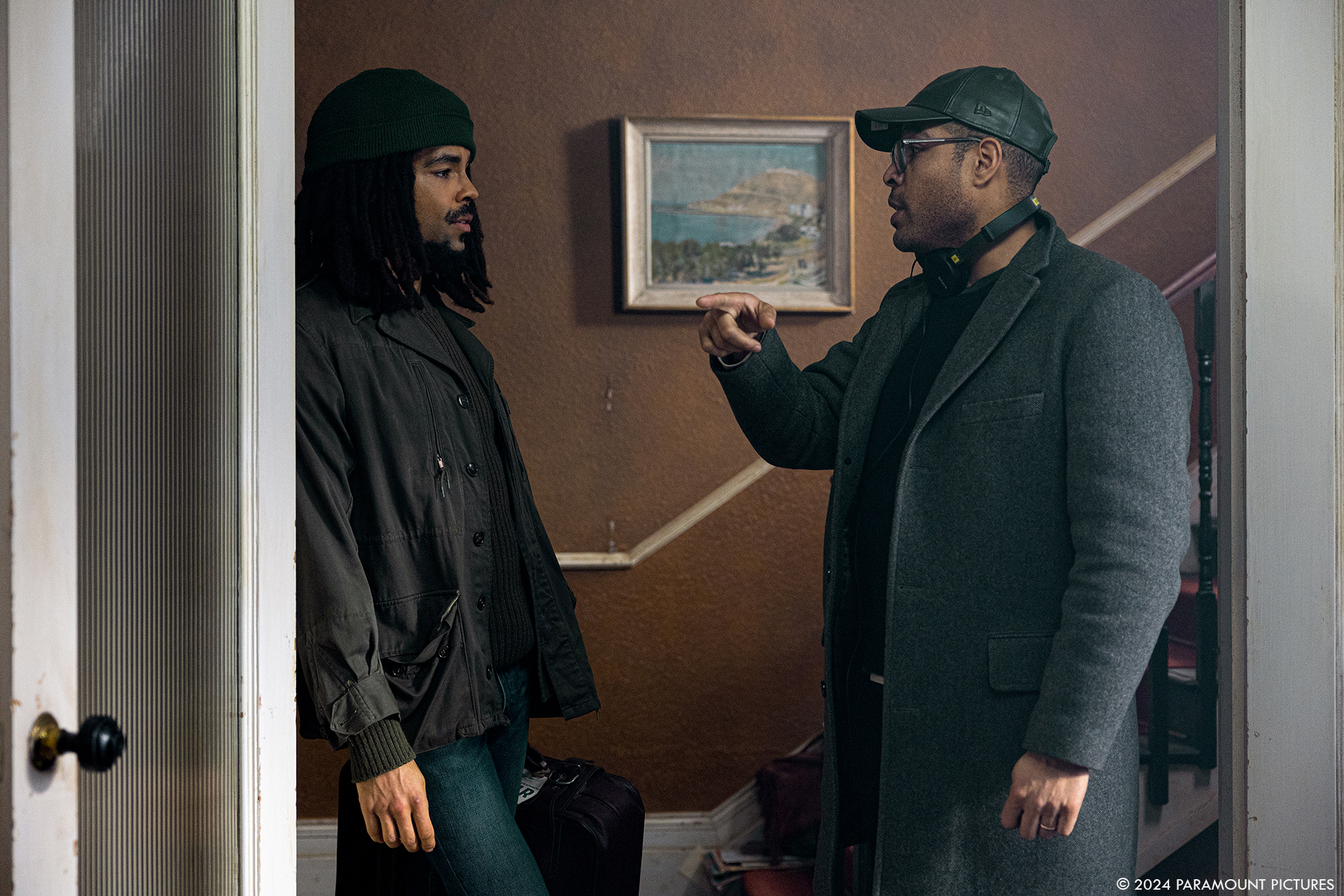
How did you organize the work with your VFX Producer?
From the beginning we had this big responsibility to portray such a well-known figure from recent history. Bob Marley has been dead for over 40 years but at the same time he’s very much alive.
From the beginning, myself and the VFX Producer, Gil James, worked hard to plan out exactly what we wanted to achieve. We started the process with a script breakdown and then we had several conversations and readings with the Director, the Producers and also the Production Designer to make sure we were all agreed on how we’d achieve the film’s visual effects in the most realistic way.
For One Love we had to rely a lot on invisible effects, and sometimes these are harder to plan for than when you’re creating big, otherworldly effects because the audience’s eyes can easily pick up when something that should look like real life doesn’t look real. We started the process of breaking down the script and also going out on location while the Art Department were still building sets out in order to do several element tests. I put together loads of reference to be able to show the Director and the DOP – the whole idea was to narrow down the vision.
How did you choose the various vendors and split the work amongst them?
From the beginning we decided to work with Outpost as a sole vendor. Initially this film was supposed to have 300+ VFX shots, largely focusing on the concert sequences with crowd, the vision sequence and some work on the Trenchtown environment. As we started shooting the project grew a lot. For us the priority was to give maximum flexibility to the Editorial team, we wanted them to have the freedom to be creative. The project grew from around 300 shots to over 700 shots. With the show growing so quickly and with the deadline remaining the same we decided to share out some of the work with other vendors. In this way we could make sure Outpost could focus on all the big sequences and hero shots and focus on creating stellar work. A lot of the additional work was clean up, beauty work, some de-ageing, which is all still demanding work and requires a lot of skill but was the easiest to place with other vendors so Outpost could focus on the major beats.
We took a lot of things into consideration when choosing our additional vendors. We had an in-house team run by Crafty Apes that could work closely with myself and the Director during the making of the Director’s cut. It was also useful because where appropriate they could create temps and send those to Outpost to work up the final shots based on that immediate feedback from myself and the Director.
We also worked with a company called Exceptional Minds that employs people on the autism spectrum, which we saw as a way to have a positive impact and their work was superb. It’s a wonderful academy and studio, and they offer a really inclusive route into the industry for people with autism. I tried to work as closely with them as I could during production to give them creative direction and support.
We did some work with Midas VFX – they specialise in beauty and de-ageing, so we gave a good chunk of beauty work to them. We also worked with Soho VFX over in Canada.
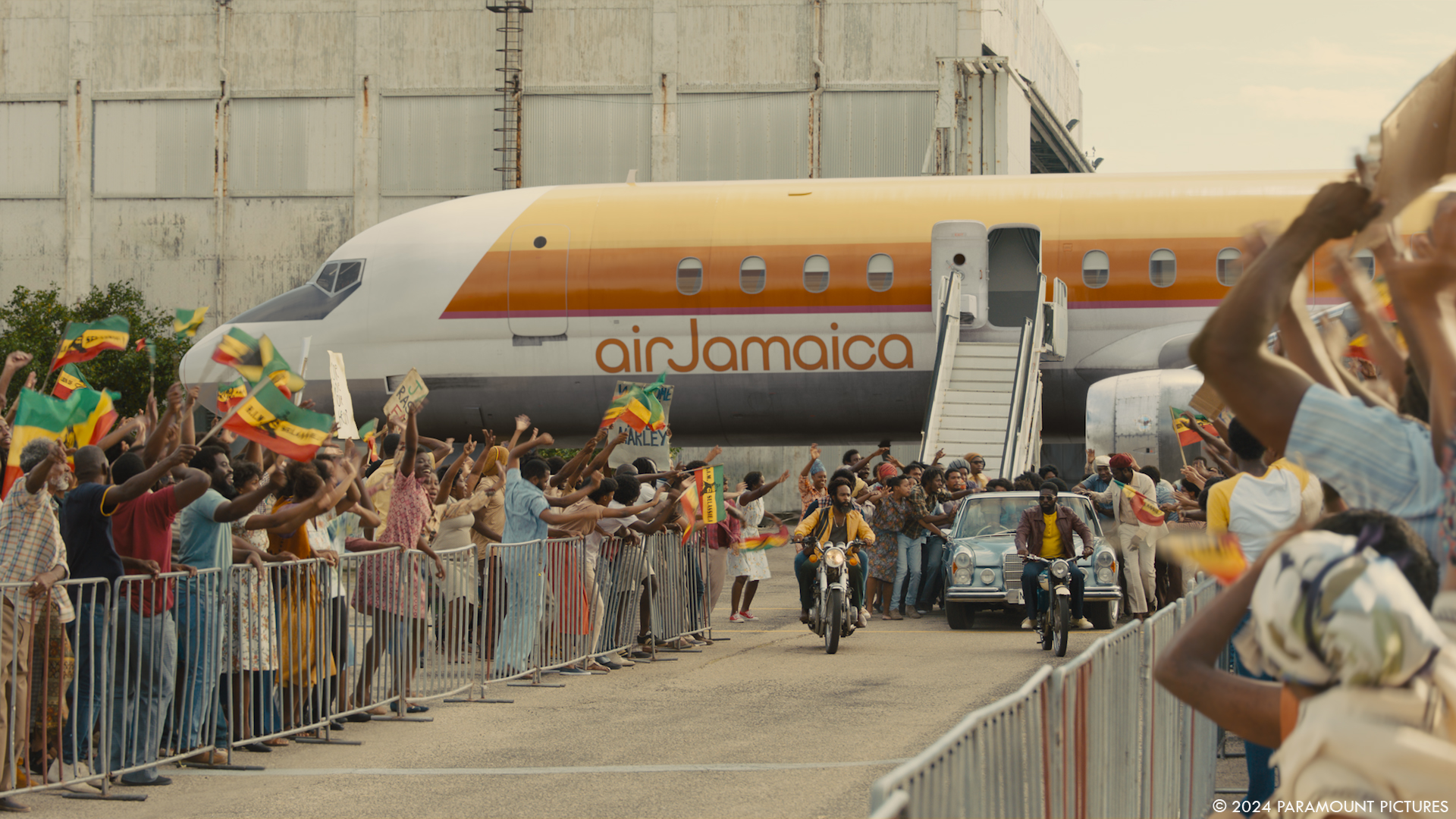
What is the your role on set and how do you work with other departments?
I would say my role on set as a VFX Supervisor is to make sure the collaboration and communication works well and is aligned across the whole project. My responsibility isn’t just to stay on set and make sure we shoot plates correctly and help the Director and DOP complete principal photography in a way that’s ready to receive visual effects, but also to keep working closely with other departments.
We were constantly in communication with the Art Department, making sure we had everything practical that we needed to achieve the end result. We were always working closely with the SFX department to collaborate with them on all the different effects in the movie, the atmospherics and the explosions.
I also spent quite a bit of time with the Camera Department to understand their lens choices and also advised them where I could on composition for certain shots to ensure the plates we had to work with later were VFX-friendly.
The amount of collaboration during a production like this is significant. I had to collaborate with the Wardrobe Department to ensure costumes worked with the blue screens we were using and for flexibility when dealing with crowd elements. The Makeup Department were in constant communication with me to make sure wigs and makeup worked well on camera and in post.
We dealt a lot with the Extras Coordinator because we had to spend a lot of time directing extras for the various crowd sequences. We had a very close collaboration with the Location crew – their job is absolutely crucial and it’s important for someone like me to work closely with them, especially on a project like this where we were dealing with many units. We had teams going out to several different locations and collecting footage, LIDAR scans and more. I really believe that the more VFX can collaborate with other departments the better the final result will be.
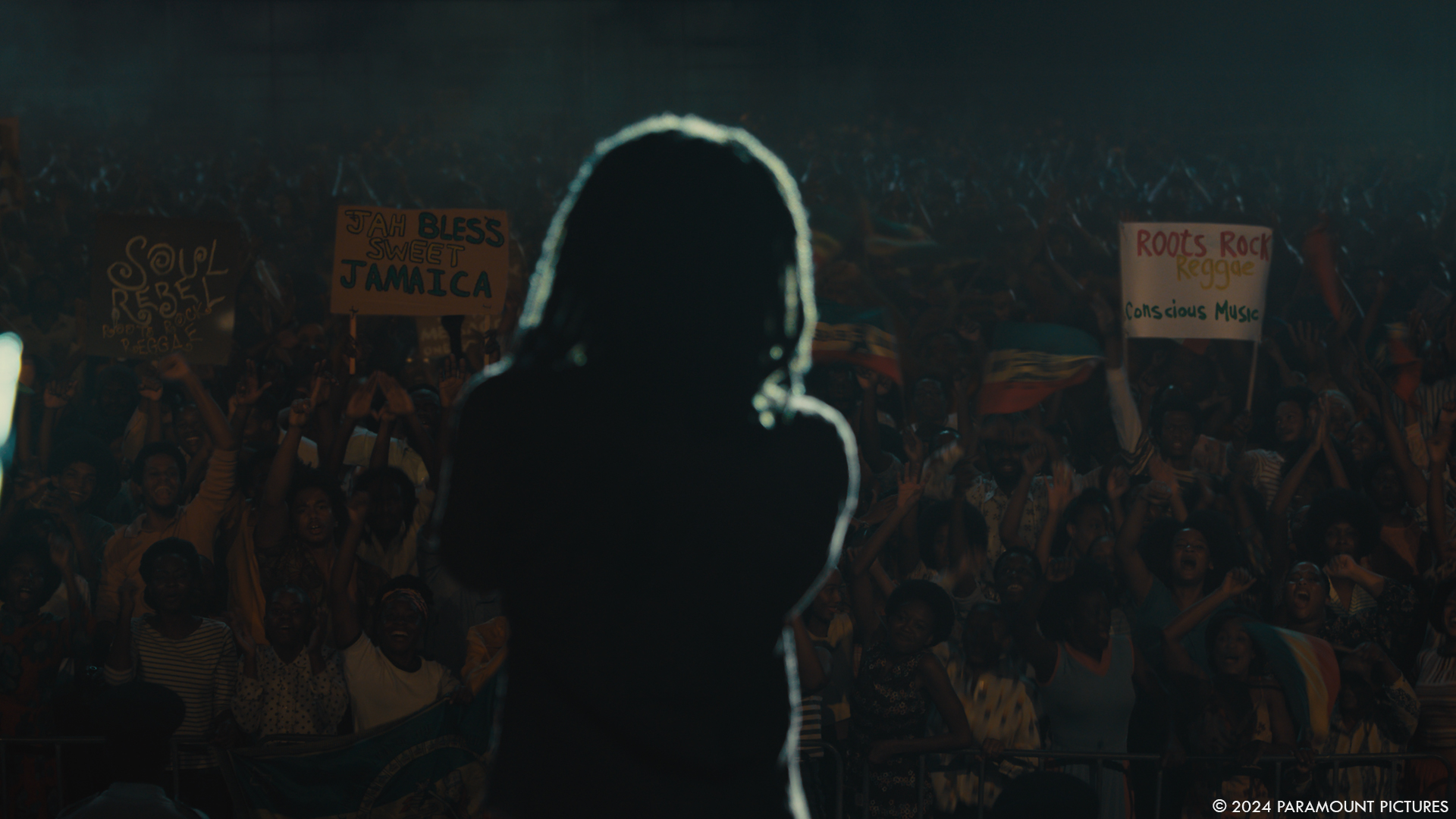
How did the use of invisible visual effects contribute to the immersive depiction of Jamaican landscapes and London set in the 1970s?
From very early conversations with the Director we knew that this was the sort of project where we had to always think about authenticity. The Marley family was involved in the production as well, and everyone was committed to making the film feel as accurate as we could. We wanted to send the audience back to the 70s, to these iconic concerts and events.
We did a huge amount of research into London and Jamaica back in the 70s. We had thousands of pictures and videos of Trenchtown back in the 70s. We did the same with London, and we also managed to rent Bob Marley’s house that he stayed in in London at this time to be as close to reality as possible.
We studied the individual concerts we were representing on screen and the venues that they took place in. We managed to re-create these iconic venues that don’t exist anymore, like the Paris Pavilion. We rebuilt this venue digitally, paying attention to the smallest details. We did the same in London with the Rainbow Theatre, which was a very famous venue. Nowadays that venue has become a church, so through using a lot of photos and archive footage we re-created every detail of that venue with VFX.
London was probably more intense in terms of the invisible VFX that were required to send audiences back in time. There were some changes we made to Trenchtown and we also needed to paint a lot of things out, but it has developed a lot less than London since the 1970s. We had whole sequences in London where the skyscrapers in the background didn’t exist back in the 70s.
We also used London as Paris as well, so we didn’t just have to make London period-accurate, but we also had to use VFX to change London into Paris, including changing the River Thames to look like the Seine.
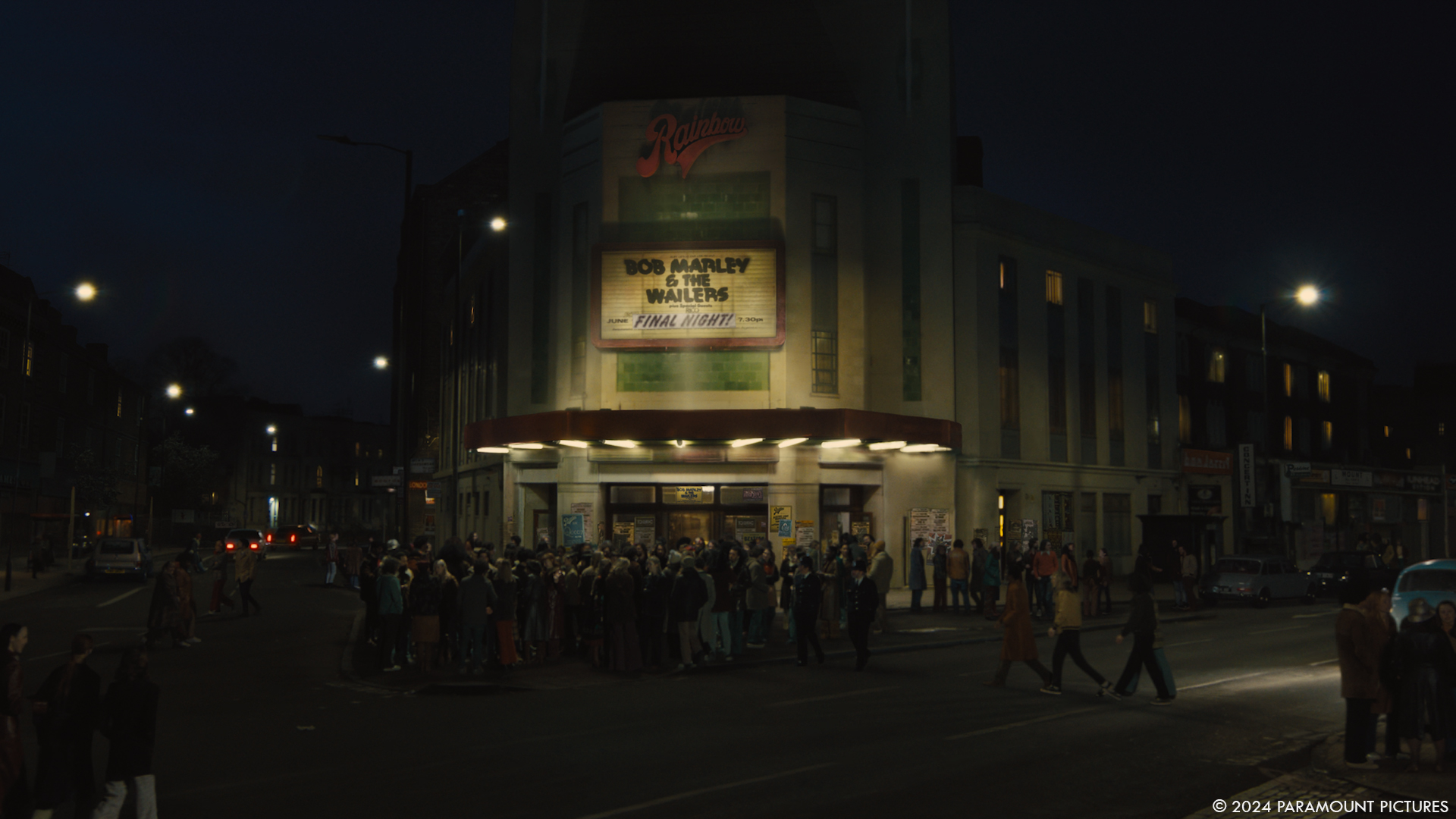
What challenges did you face in accurately recreating the ambiance and architectural nuances of London?
London is obviously a very recognisable and iconic city, and we were fortunate to shoot on location there as it meant there was less of an overhead in terms of building environment extensions. There was a lot of work to do in making modern London look like the 1970s, however. There are many shots where we’ve had to remove the modern London skyline as it’s changed so much since then, and then there was the usual overhead of paying attention to road markings, period-appropriate vehicles and much more. There are many shots in there where we had to use CG vehicles to populate the roads. For the Rainbow Theatre, an iconic venue that closed back in the 80s, we were able to shoot the building as it is now and then worked from reference to replace all the signage so it looked how it did when Marley played there in the 70s, and then we added CG vehicles and integrated crowd elements to show people waiting to go into the concert. The fact that the building is still standing made it easier for us to achieve the authenticity we were looking for.
What was the most complicate location to recreate?
I would say the One Love show Marley played when he returned to Jamaica following his exile in London. The venue for the show was the Jamaican national stadium, Independence Park. We weren’t able to shoot anything at the real stadium so instead we shot the sequence at a big, open park, and we had to use VFX to re-create the stadium in as much detail as possible. We went to Independence Park with our LIDAR team who did drone scanning as well as LIDAR. As an environment that was the most complex to create because we also had to adapt the data we got as the stadium has changed a lot since the 70s – once again we had to use archive footage to understand things like what the scoreboard should look like, what the floodlights looked like. The level of detail was incredible. Obviously the concert happened at night so we lost some of those details due to the lighting, but it was really important to us that we were as accurate as possible. We also had to take into account a crowd of around 30,000 people. When we shot the plates we had about 100 to 150 extras available for crowd rep in other sequences, but the lighting we went with to shoot the plates ended up not matching the lighting we wanted to use for that sequence specifically, so we had to rely entirely on CG crowd simulation for this concert.
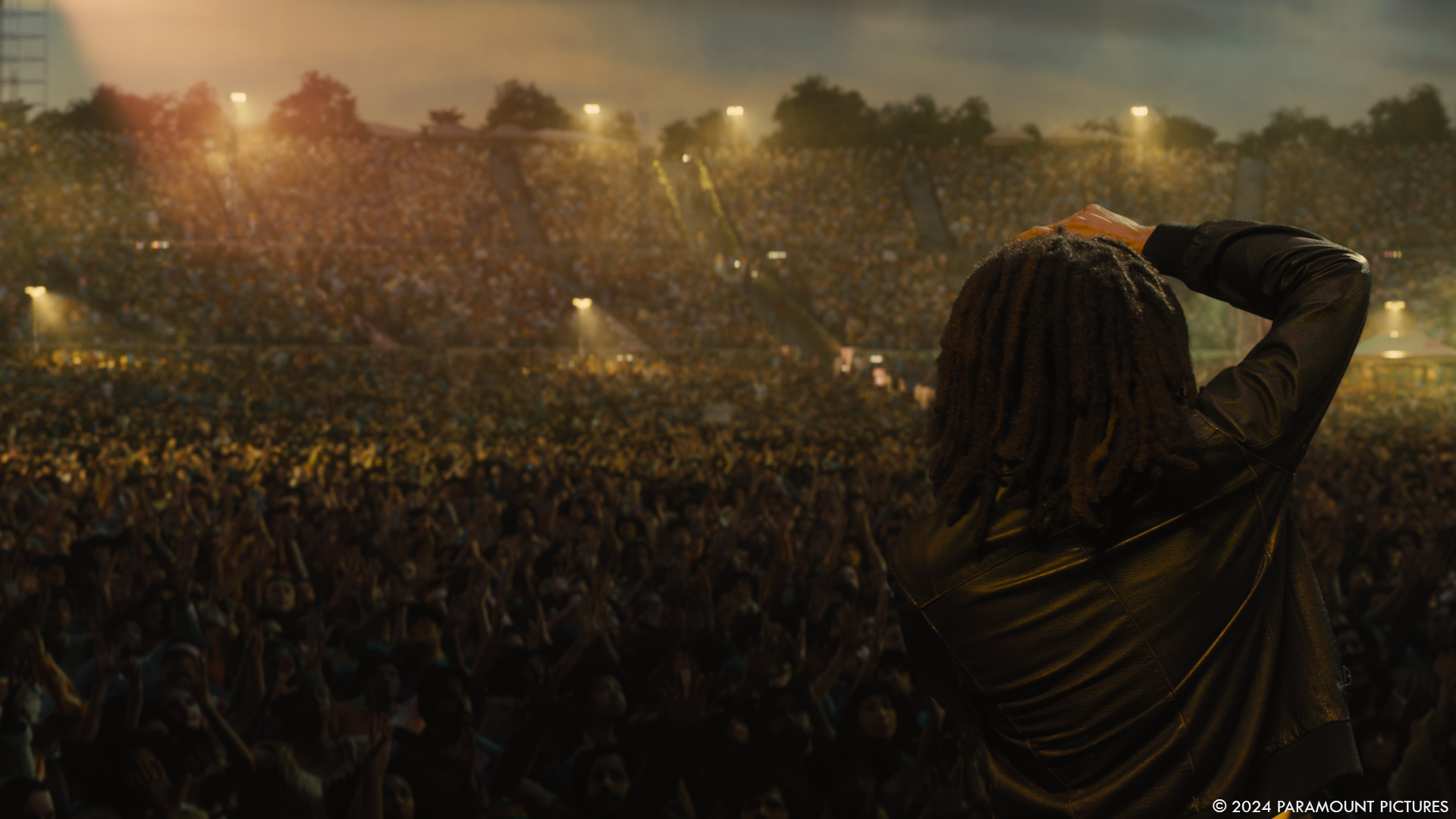
Could you elaborate on the creative challenges involved in rendering for a compelling bushfire scene?
That sequence was always a very delicate sequence for the Director. He wanted to give the audience an abstract glimpse into Bob Marley’s background and how that affected the person he became. The Director decided to use Jamaica’s famous sugar cane fields and a process that they still use today where they burn the sugar cane, and it burns super quick. The tricky part of that sequence was we had to have a horse, a rider, a child, a sugar cane field and loads of fire. The whole idea was that the kid was running through the sugar cane field and arrives in a clearing, where it becomes a ring of fire. We knew from the beginning we’d never be able to shoot that practically due to health and safety issues, but also because we wouldn’t have the flexibility to position the camera exactly where we wanted. We decided to work in collaboration with the SFX team to use some gas bars in very specific places in this clearing. The clearing didn’t exist in reality and we asked the Art Department to build two walls, one in front and one behind the boy, and then we replaced these digitally later. The smoke and the fire from the gas bars were crucial for us to generate good lighting reference. We strategically placed them at a safe distance from the child actor but it still gave us a nice lighting wrap on the kid, the horse and the rider. We’d then move the gas bars according to the DOP’s framing to make sure we got a realistic result. It then helped us to replicate and digitally extend the rest of the fire and create an asset of a perfect ring around the performers.
One weekend while I was in Jamaica and had a small amount of downtime, I managed to wrangle two cameras and then went with a visual effects team to burn a sugar cane field for real, which is a normal process as before you collect the sugar cane the farmers need to burn the field anyway. It was an amazing process. We had two fields, each about 200 metres long, and the farmers set fire to them. In a matter of minutes the whole field is completely on fire but it only takes about 15 minutes for the fire to burn all the dry leaves and then extinguish itself. It’s a really well controlled fire and normal practice.
It was crucial for us to have two cameras shooting two fields burning so we had enough data. We managed to get a lot of practical embers, smoke and fire, and this was incredibly helpful for shots where the fire was in the distance and we could use the footage as elements. It was also great footage to give to the FX crew at Outpost as they could replicate it in Houdini.
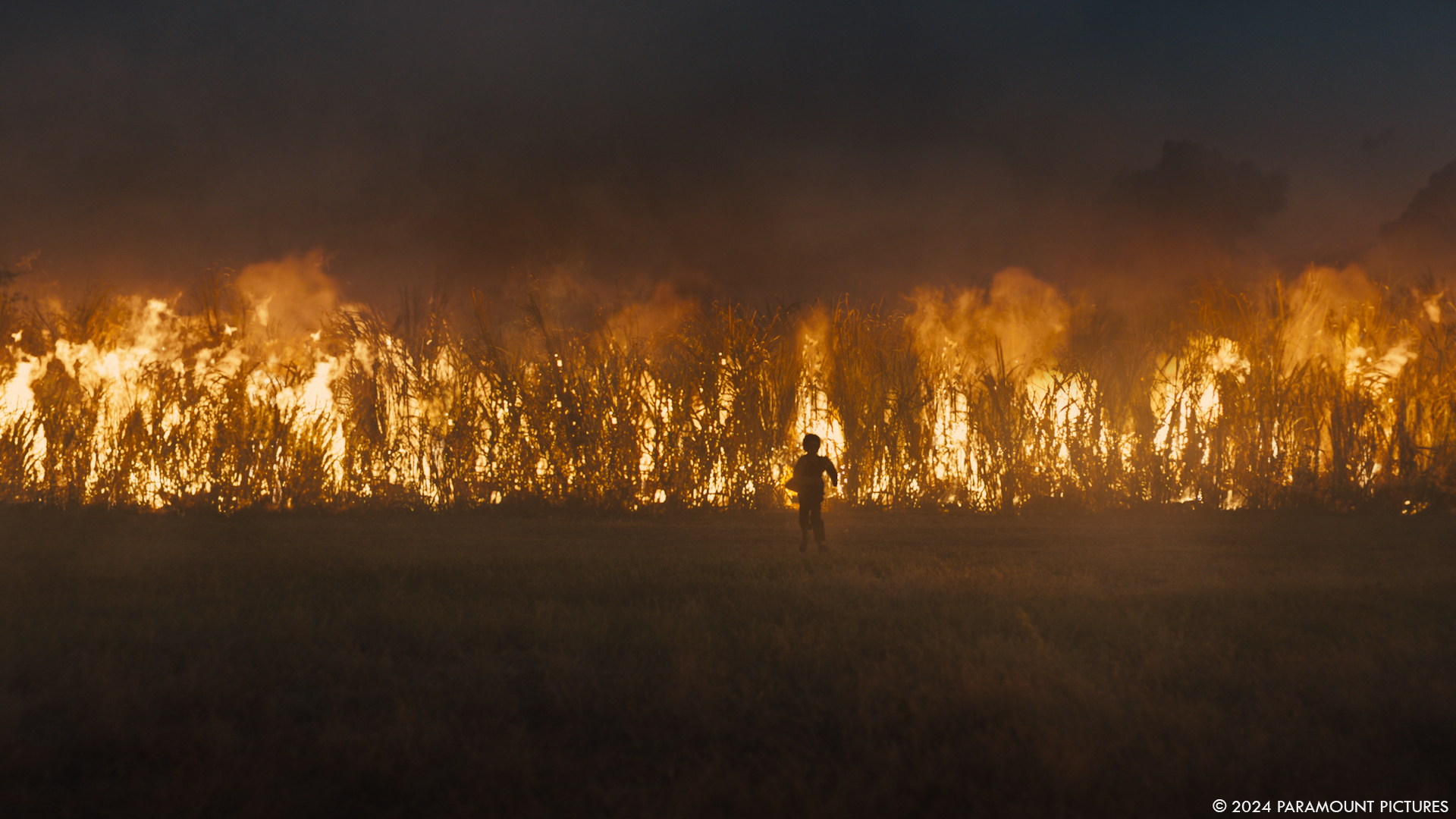
What animation techniques were employed to simulate the dynamic behavior of flames and smoke in the bushfire scene?
As I’ve discussed we had the results of a number of element shoots that gave the team at Outpost a good foundation to work from, but where we needed to expand the fire and control its behaviour, we worked with the FX team to develop and integrate fire and smoke simulations out of Houdini. This was especially important when we were working on the wide shot where the fire extends out into a ring around the boy and the horse and rider.
How do you tackle the challenge of creating and animating realistic crowds to fill stadiums and concert halls, while ensuring each individual appears unique and believable?
The Director was determined to make the crowds feel as real as possible, so what we decided to do was approach it in two ways. We had the photography, where we shot up to 200 extras dancing to the right music that would align with what was playing in the film. Then after principal photography we asked the Camera Department to shoot all of this again but with tiling, so we could shoot the extras then shuffle them and move them out of place, before trying to shoot again with the same camera movement. This allowed us to have a foreground of real crowd rather than just using a digital crowd. As well as this we also set up some blue screens on the studio stage to shoot some 2D elements. We worked with the Lighting Department to replicate the same lighting that was used during principal photography and used the same music so the dancing was consistent. We shot elements of single people, of groups of two or three people, a then a bigger crowd. We had two cameras rolling so we could shoot on the ground with eyeline, then another pointing 45 degrees down as this would be perfect for integrating into crane footage.
Once we had the principal photography and the 2D elements, we had enough footage in most sequences for the foreground and the midground to be filled with real people, which was the realistic result we were looking for. Then we started to look at digi doubles and crowd simulation for the background crowd. We invited Visual Skies to join us on the project to do a lot of the LIDAR on the venues, but when it came to the crowd we built a cyberscan booth in London where we managed to scan all the extras, and then we asked them to join us in Jamaica so we could do the same thing with the extras there so we had enough scans to build diverse crowds based on where the concerts were taking place. We also wanted to make sure the animators had the best starting point when it came to animating all the dancing, clapping and idling, so we worked with the mocap company Centroid and they spent the whole day recording several types of performance that we could use for our digi doubles.
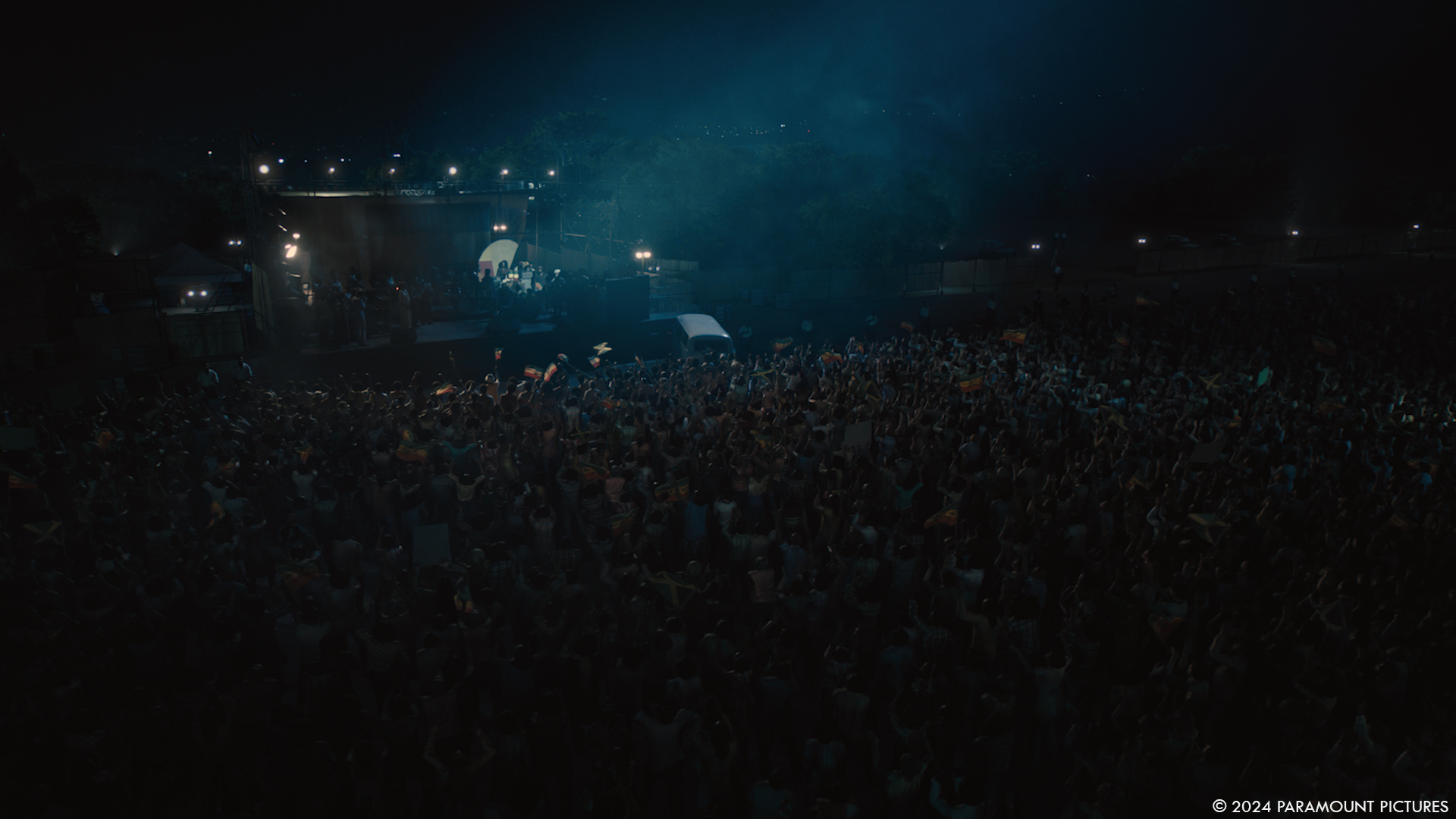
In terms of lighting, how do you manage to create dynamic lighting within virtual crowds?
Like with most things this began with reference so we could understand what the Lighting Technicians were doing back when Bob played these concerts back in the 70s. There was then the task of re-creating these techniques practically on set, and then matching this with CG lighting that could interact with our crowd agents in the same way it would if it were all real.
Can you discuss any specific scenes where visual effects were particularly challenging or innovative?
There is a sequence during the movie that’s a bit of a montage, where the Director wanted to show a montage of Bob Marley’s tour after the release of Exodus. The whole idea was to shoot several concert shots, but then we needed to create an environment for the whole European tour that went to places like Denmark, Germany, London and Paris.
The main issue we had was we wanted to be consistent with the real venues that Marley actually played on the tour, but we shot everything in the same place due to schedule issues. We shot all of this at Alexandra Palace, London. We decided to shoot on blue screens but with a lot of atmospherics, which was very challenging, and then we needed to create different environments for each of the different venues around the world to a very high level of detail, which were then used in a single montage-style shot.
Because it’s meant to look like the 70s, we found it a challenge to find a lot of archive photos of all these different venues to use as reference. It was a lot of work to create those venues so they looked different enough to create the sense of montage, as well as maintaining that high level of accuracy that we were trying to achieve.
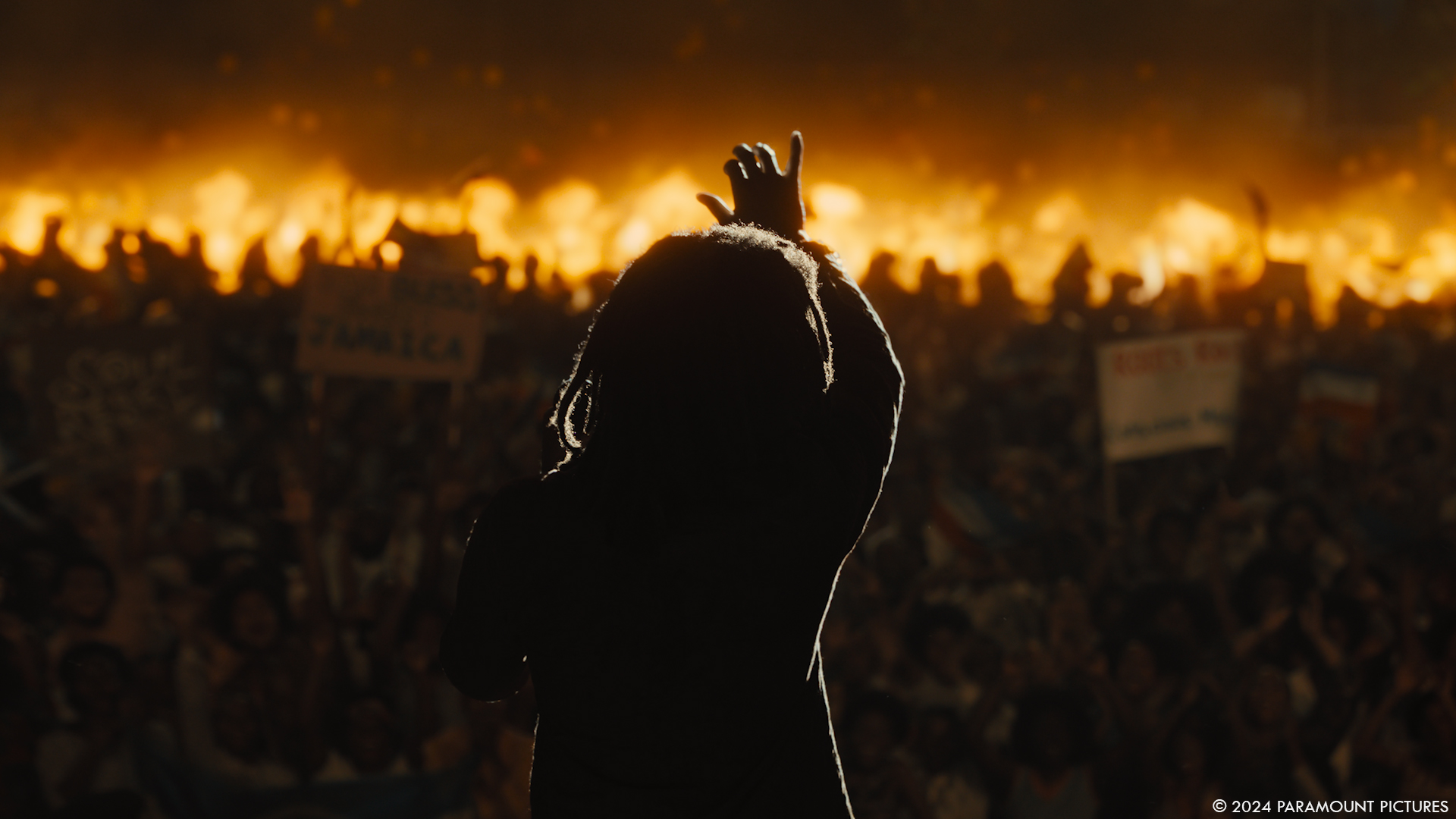
Looking back on the project, what aspects of the visual effects are you most proud of?
I really like the result we achieved for the vision sequence. I think the fire on the sugar cane field looks absolutely gorgeous and we managed to capture the idea of the vision with beautiful lighting and realistic fire. I’m very proud of this sequence, the team at Outpost did a fantastic job.
Tricky question, what is your favorite shot or sequence?
My favourite sequence was the One Love concert in Jamaica where we created Independence Park. There was a lot of work involved in bringing that to life and it made such a big impact on the final film.
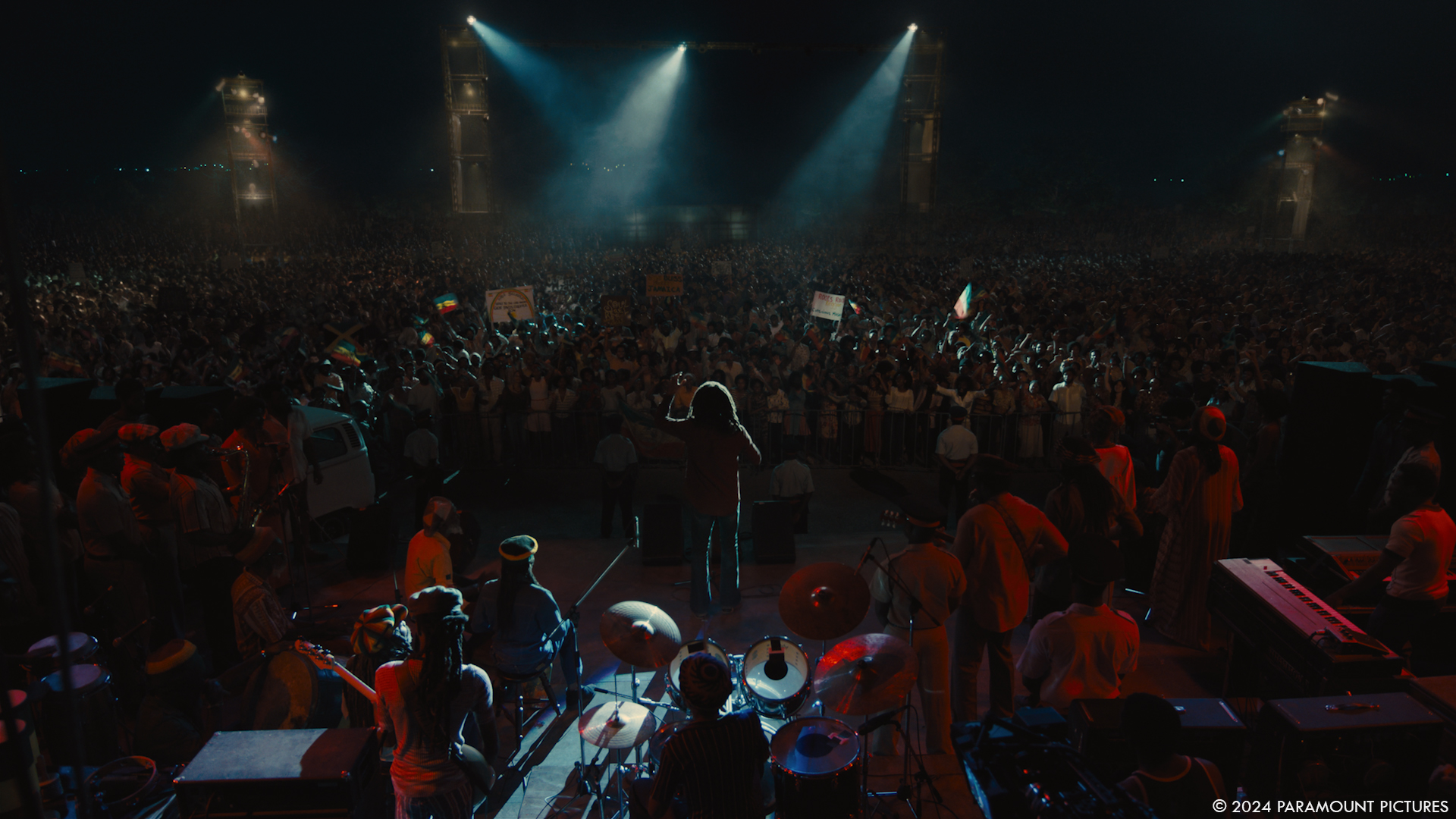
How long have you worked on this show?
I was working on One Love from October 2022 so it ended up being a little over a year in total.
What’s the VFX shots count?
We created just over 700 shots for the movie.
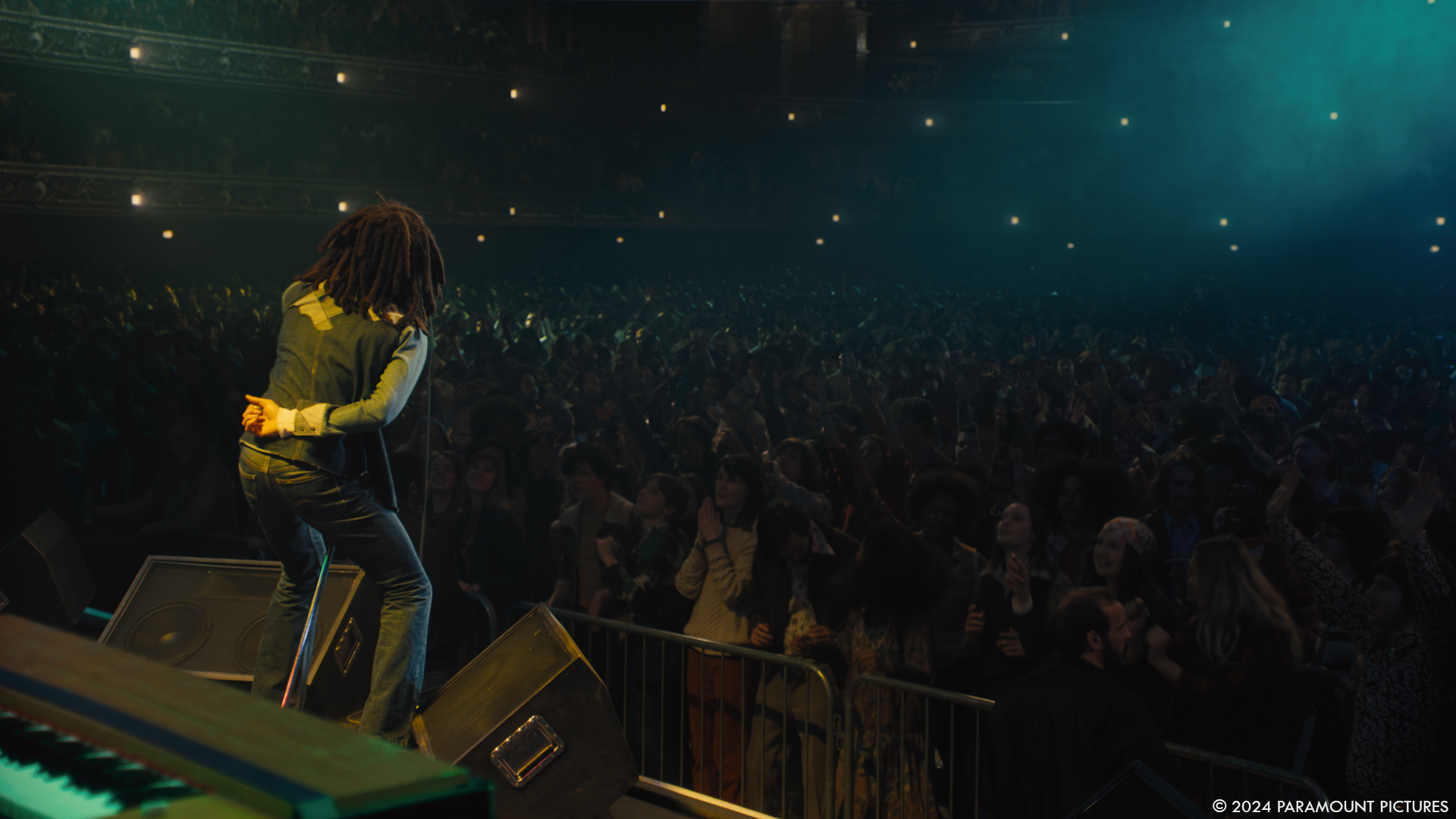
What is your next project?
I’ve got a few potential projects lining up at the moment but I can’t discuss them just yet!
What are the four movies that gave you the passion for cinema?
The movies that had the biggest impact on me were City of God; Gulliver’s Travels because it really opened my eyes to visual effects; Jason and the Argonauts was so impressive and had a big impact on my childhood, especially the animation of the skeletons; and the fourth one would be The NeverEnding Story. I was just a child when I watched that and it was so magical.
A big thanks for your time.
WANT TO KNOW MORE?
Outpost VFX: Dedicated page about Bob Marley: One Love on Outpost VFX website.
© Vincent Frei – The Art of VFX – 2024





